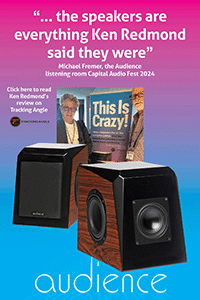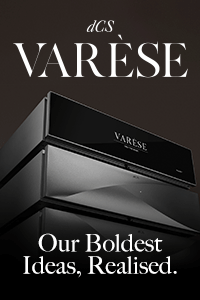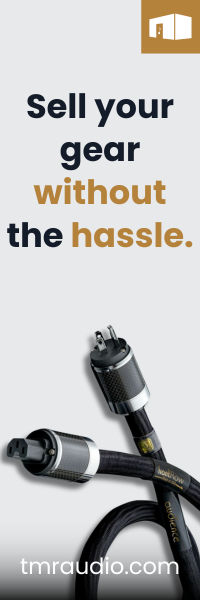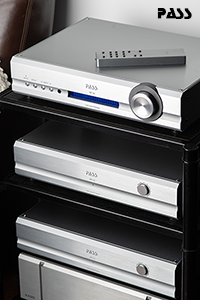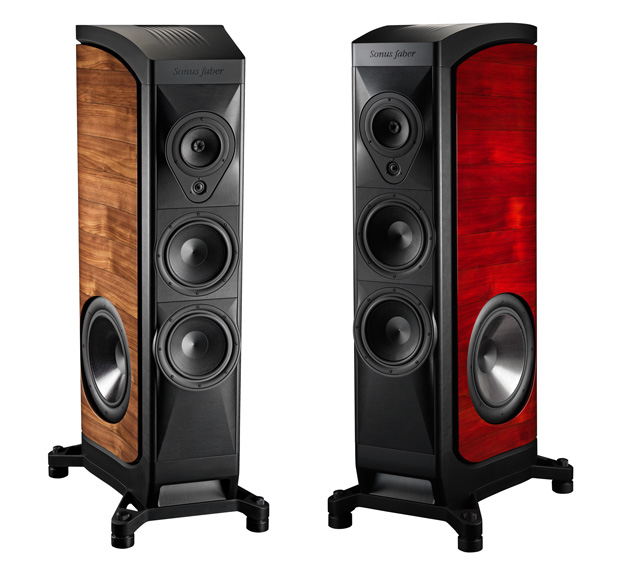 If you are a lover of mega-speakers, be sure to read Ken Kessler’s article about his visit to luxury speaker manufacturer Sonus Faber in issue 31. These beauties have a $150k price tag and only 30 lucky people will be able to purchase a pair! As is typical with SF, they are an object of beauty…
If you are a lover of mega-speakers, be sure to read Ken Kessler’s article about his visit to luxury speaker manufacturer Sonus Faber in issue 31. These beauties have a $150k price tag and only 30 lucky people will be able to purchase a pair! As is typical with SF, they are an object of beauty…
Sonus Faber’s New Flagship: Fenice
Wayne Coyne of the Flaming Lips
As witty and fun in person as he is on record, Flaming Lips frontman Wayne Coyne is full of big ideas. With his band having just released Embryonic and an updated version of Pink Floyd’s Dark Side of the Moon, he reflected on the process of putting out two records in such a short time and how the group decided to take on such a classic recording.
While available as an iTunes download since December, the album will be available on LP this Saturday in honor of Record Store Day, for $24.
TONE: How long was the Dark Side project in the making?
WC: As we were finishing Embryonic, the iTunes management wanted some exclusive bonus tracks for the iTunes store, and quite frankly, we didn’t have any. I posed the question of us doing Dark Side of the Moon because I knew my nephew’s band (the White Dwarfs) was very familiar with it and I knew it could be really fun. Ten minutes later, the Apple guys were happy with the idea and we were off.
TONE: Were there any snags in the production? Did you hit a point where you felt that perhaps you had too much of a mountain to climb?
WC: When we got together in the studio, it all fell together relatively quickly and was pretty painless. It was the same thing with Peaches; she raps a lot but she’s a crazy singer. Her vocal to “Great Gig in the Sky” was fantastic – that’s a tough one for anyone to pull off.
TONE: Who decided to have Henry Rollins do the voiceovers? Are you guys big Rollins fans, or did you just decide at lunch that he was the man?
WC: We already knew Henry and we all agreed he would be perfect if his schedule would permit. When we ran it past him, he responded almost instantly. It was all done remotely. We sent him the music and he sent back the tracks we needed, along with plenty of alternates to choose from. Henry is a great guy to work with.
TONE: It was very cool that you took such a creative perspective on Dark Side by making it such a different piece of music. It’s good to see that you just didn’t go Dream Theater on it.
WC: (laughs) Well, we wanted to make sure it had our stamp on it.
TONE: Having recently finished Embryonic, was it grueling to put out another record two months later? Was it tough to keep two very different streams of creativity straight in your brain?
WC: Actually, Embryonic was released in a relatively short time for us—only about three-to-four months. By the end of the record, we had been going in a certain direction with the things we learned from the Embryonic sessions, so the new direction with Dark Side was a fairly easy transition.
TONE: The current tour shows dates from March to June here in the US. Are you guys taking some time off now?
WC: We have more things to announce, but we can’t chat about that right now. When I talked to someone about the idea of doing Bonaroo this year, it was on the Internet in 30 minutes and pretty much all around the world instantly. So we are definitely on the roster, but I’m hesitant to let anything out right now, as I know it will be on Facebook in about 8 minutes.
TONE: Will the Lips play Dark Side anywhere else besides at Bonaroo? Speaking of that fest, Steve Martin is going to be playing banjo there. Will you guys invite him up onstage to collaborate? That would be trippy!
WC: Now that’s a great idea. Let’s formally announce right here that we will try to get Steve Martin to perform a song with us at Bonaroo. And we will be performing DSOM in its entirety at Bonaroo. If you get a chance, listen to Steve Martin’s autobiography, which he narrates on iTunes. It’s very interesting and lends a lot of depth to his personality. We listened to it on a long road trip recently and it was much more engaging than Obama’s autobiography.
TONE: How has Dark Side been received? Has it added to or distracted from the material on Embryonic, seeing that both records were released so closely together?
WC: Good question. So far, our fans seem to be enjoying both records equally. It’s always our hope that you can enjoy the spectrum of what we do. I’m glad people still love and talk about Yoshimi Battles the Pink Robots, but I always hope they will enjoy the latest work as well.
TONE: Was Steven Colbert a pretty cool cat when you recently played his show? Is he a big Flaming Lips fan?
WC: Playing the “Colbert Report” was great. Steven is an outstanding host and a really hard-working guy. He’s there before you are, making sure everything is in its place, etc. A lot of the guys on his staff are big fans too, so it was a great experience.
TONE: Do you get tired of people referring to you as a psychedelic band? I always like to think of the Flaming Lips as a highly complex band.
WC: I look at the psychedelic label as just the ability to be a little more creative with what we do, not sticking to a particular song structure or music structure. I’m 49 years old, so my interpretation of psych is perhaps a little different than some of our fans in their 20s who don’t have the same perspective on the Grateful Dead or punk rock. But it’s still more of a creative way to look at things.
TONE: You made a comment a while back, saying, “Hovering above complete failure gives you a lot of creative freedom.” I’d hope you guys are doing a bit better than that these days.
WC: In order for us to live our dream of making music, touring, and the like, you have to have a certain level of organization and discipline to make it all work. We have to keep everyone fed, so they can keep making music.
Photo, courtesy J.Michelle Martin-Coyne
The Clearaudio Concept Turntable
While known for their megabucks, state of the art turntables that can run into the six figure range, Clearaudio has produced a winner for the audiophile that doesn’t have a fortune to spend with their new Concept turntable. Priced at $1,400, it is a belt drive table that features a tonearm that I’d expect to pay $1,400 for alone, utilizing a magnetic bearing with outstanding build quality.
Clearaudio dealers have been offering a package price on select Clearaudio cartridges bundled with the table. As I just happened to have a Clearaudio Maestro Wood moving magnet cartridge sitting on the shelf, it was the perfect match for the table. (I believe you can buy the two as a set for $2,200)
The full review will be up on the Gear section of our website shortly, but I think the Concept is the new heavyweight champ in the $1,500 turntable range. Stay tuned for more info…
Marco Benevento Trio Live
After reviewing his latest album Between The Needles And Nightfall a few issues back, I was certainly up for seeing Benevento’s trio live at the best sounding venue in the Northwest; like the record, I came away impressed with the performance and the sound. Benevento’s recent albums showcase his ability to create magic, sonic landscapes, but the live show is a different story. This jazz trio is really a jam band in disguise. Benevento uses a series of effects pedals at the feet of his baby grand piano, and just like a guitarist, uses them to great effect. At times, his sound went straight to the PA system, and others, he routed them through an ancient vacuum tube practice guitar amp with a great result.
This performance kept the strong melodic backbone of the recordings, but the way the drummer and bassist kept their lockstep rhythmic foundation was reminiscent of a precision fusion band more than a traditional jazz trio. Whether they were performing some of the original material off the latest album or covering Amy Winehouse’s “You Know I’m No Good”, the band held the audiences rapt attention. They stretched out quite a bit but never let go of the tension created between the melody and the attack. The crescendos “The Two Of You” and a few others felt like a sonic wave crashing off the walls of the club. As a relief from that tension, Benevento played a few tunes on his toy piano, replete with comical stage antics while still being pummeled by the rhythm section.
Marco Benevento is a joy to see live. He has an amazing ability to compose songs that have memorable melodies that translate well to a forceful, if slightly unorthodox fashion on stage.
MiniWatt’s Latest: The N3!
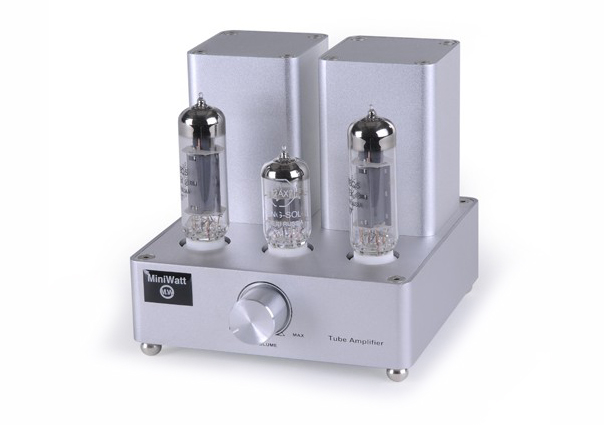 For those of us that have relatively large power amplifiers, one watt probably wouldn’t make much if any difference at all, but when you’re in the low watt (i.e. under 10 watts per channel) camp, every bit counts, and quality is everything. In case you missed all the buzz about the MiniWatt S1, we were very enthusiastic about it when it was reviewed about a year ago. Click here to read our past review. The original MiniWatt S1, barely tipped the scales at $229, and the new N3 is still a killer bargain at $378.
For those of us that have relatively large power amplifiers, one watt probably wouldn’t make much if any difference at all, but when you’re in the low watt (i.e. under 10 watts per channel) camp, every bit counts, and quality is everything. In case you missed all the buzz about the MiniWatt S1, we were very enthusiastic about it when it was reviewed about a year ago. Click here to read our past review. The original MiniWatt S1, barely tipped the scales at $229, and the new N3 is still a killer bargain at $378.
The new N3 not only has 3.5 watts per channel, as opposed to the 2.5 watts per channel of the S1, it uses a very different circuit. Now, it features a more classic tube lineup, using a 12AX7 as a driver and a matched pair of Sovtek EL84’s as output tubes. The single volume control remains on the front panel, but turning the amplifier around back, you will notice that there are now 4, 6 and 8 ohm taps for speaker outputs. This is very handy to optimize the amplifier to your speakers. Again, with 3.5 watts per channel, you don’t want to lose power on speaker mismatch. If you are a budding audiophile and aren’t familiar with this concept, try all three taps to see which one provides the most effortless sound with your speakers, that’s the one to go with.
Currently, the only place in the US to purchase the MiniWatt N3 is from ALO Audio, (www.aloaudio.com) which just happens to be in my hometown of Portland, Oregon. Non US shoppers can purchase directly from MiniWatt’s online shop. (www.miniwatt.com.hk) After some initial listening, Ken and I discussed the merits of the new amplifier over a couple of most excellent chili dogs at Zach’s Shack, which is right across the street from his storefront. If you are anywhere near Portland, I highly suggest a short drive to pick one up in person and grab lunch at Zach’s while you are at it. There’s a lot of great record stores here in Portland…
Setup
The N3, like it’s predecessor is a snap to set up. As long as matched output tubes are used, the bias does not need to be futzed with, though the manual does not specify how to adjust bias if you have an unmatched set of tubes. For now, I suggest just buying a matched pair when the time comes. MiniWatt claims up to five years on the output tubes and up to ten years on the driver. You’ll probably make a change in your system before that!
Most of the review took place with my Zu Essence speakers that feature a sensitivity of 98db. While the N3 will drive less efficient speakers, I’d really make a high sensitivity speaker my first choice with a few watts per channel if you want serious volume. With a speaker like the Zu’s or perhaps a pair of vintage Klipsch speakers, you can really rock out with 3.5 watts per channel.
Fortunately, the N3 does not use an external power supply, but features an internal switching power supply that can be reset to any voltage in the world. This is good for two reasons: you won’t lose or confuse yet another wall wart and you can use a real power cord (which is not included with the N3). I used a Shunyata Venom ($125) with excellent results and felt it kept within the budget ethos of the amplifier. The rest of the reference system was rounded out with Zu Libtec speaker cables, and a Rega Apollo CD player.
Big Sound
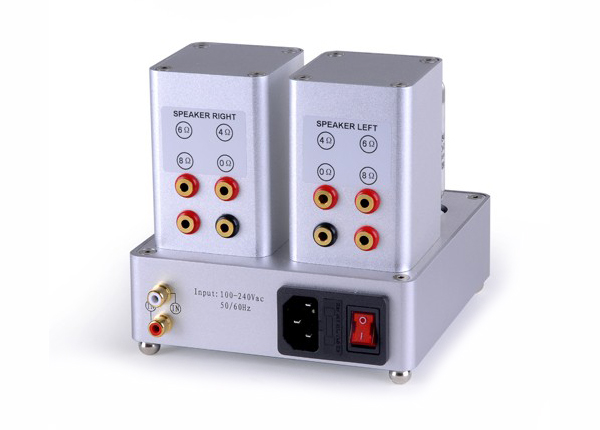 While I’d like to rave about the extra watt, the N3 is really more about quality. Comparing the two amplifiers side by side, you immediately notice the extra body and three dimensionality of the Mini Watt’s latest offering. The easiest comparison will be your favorite solo vocals; listening to some of my favorites from Johnny Cash and Anya Garbarek, the new amplifier sounds as if I moved my speakers a few more feet apart instantly. Once the amplifier had about 100 hours on the clock, it improved a bit, with acoustic instruments having slightly more body.
While I’d like to rave about the extra watt, the N3 is really more about quality. Comparing the two amplifiers side by side, you immediately notice the extra body and three dimensionality of the Mini Watt’s latest offering. The easiest comparison will be your favorite solo vocals; listening to some of my favorites from Johnny Cash and Anya Garbarek, the new amplifier sounds as if I moved my speakers a few more feet apart instantly. Once the amplifier had about 100 hours on the clock, it improved a bit, with acoustic instruments having slightly more body.
Small tube amplifiers lend themselves to acoustic instruments and the N3 is no exception. Digging out some Michael Hedges tracks, this amplifier does a great job at capturing Hedges plucky, dynamic style and while having enough headroom with the Zu’s to make the presentation convincing.
Probably the only area that the N3 falls down somewhat is deep bass. This is probably due to the compact power supply more than anything, because the circuit design is sound. If you’re thinking that a 3.5 watt amp can’t have bass grunt, the 2 watt per channel Decware Zen has it in abundance, but is almost $800. Horsepower costs money. For most people the N3 will be fantastic. When playing some of my favorite club tracks or heavy rock favorites, I noticed that the Zu’s didn’t quite lock into the room as much as they have with other amplifiers, but 95% of the time I didn’t notice.
If you don’t have a pair of Zu’s or some other single driver high efficiency speaker, the N3 excels at being part of a great desktop system. Used in conjunction with the iMac on my desktop and a pair of their N2 full range speakers ($799), the MiniWatt system offered up a huge share of fun. Thanks to it’s single driver design, the N2 doesn’t waste any precious power in a crossover network and allows the maximum amount of midrange detail to come through.
Conclusion
MiniWatt has hit another home run with the N3. They still make the S1 for those on a super tight budget, but if you’ve got the extra $150 in your wallet, I highly suggest stepping up to the N3. If there’s a better sounding tube amplifier on the market at this price point, I haven’t heard it yet!
Watch Gene Simmons Sunday on A&E’s Private Sessions
Just had a fantastic time chatting with the host of A&E’s Private Sessions, Lynn Hoffman this afternoon.
Every bit as warm and friendly in person as she appears on VH-1 Classics or Private Sessions, Lynn shared quite a few insights on her career, handling rock stars and what she’s listening to today. Watch for the full interview in issue #31, due out around August 17.
In the meantime, check out her show on A&E this Sunday morning (9 a.m. EST./8 Central), when she hosts Gene Simmons from KISS and Gene Simmons’ Family Jewels. Here’s a clip that will give you an idea of what’s in store:
TONEAudio Magazine Issue 30
Features
The Big Four: Metal Giants Together at last
By Bob Gendron
Tom Petty and the Heartbreakers: They Got Mojo Risin
By Ben Fong-Torres
Budget Gear: Mordaunt Short Aviano 6
By Mark Marcantonio
Old School The JBL-L100 Century
By Jeff Dorgay
Behind the Scenes With Metal Photographer Mark Latham
By Bob Gendron
Tone Style
The Panasonic Lumix DMC-ZS7
Mighty Light and Mighty Light HD
The ZDock for your iPod
Skooba Design’s Cable Stable DLX
The Magna Cart Flatform Truck
Altec Lansing IMT 320
KISS Picture discs
Music
Live Music: The TONE Staff Covers Tom Petty, Jeff Beck, Crash Test Dummies and more…
Current Releases:
Fresh Releases in the Pop/Rock World
By the TONE Staff
Audiophile Pressings
New Releases from MoFi and Music Matters Jazz
By Jeff Dorgay and Richard Colburn
Alternative Divas
Give Patricia Barber a rest!
By Jeff Dorgay
Time Flies…1994…2009
The Oasis box set
By Bob Gendron
Sony’s Legacy Setlist Series
By Bob Gendron
Downloads
Some new high res files from Reprise and HD Tracks
By Jeff Dorgay
Previews
NuVision Lucidium Television
ARC’s REF Phono 2
Reviews
Headphone Planet: Decware Headphone Amp and New Phones From Phiaton
By Jerold O’Brien
First Review! The Magnepan 1.7
By Steve Guttenberg
The AudioQuest LeoPard Tonearm Cable
By Jeff Dorgay
PS Audio’s Perfect Wave Transport and DAC
By Lawrence Devoe
The EAT KT-88 Vacuum Tubes
By Jeff Dorgay
The Verity Finn Speakers
By Jeff Dorgay
The Keith Monks Ruby Record Cleaning Machine
By Jeff Dorgay
SLUMMIN’
Sex Pistols
jeff beck
Here’s a few extra shots of Jeff Beck from the current tour…
Full review in TONEAudio #30, out shortly!
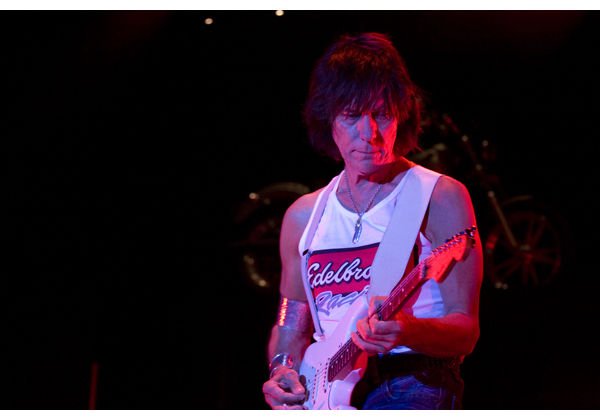
Definitely a master of focus.
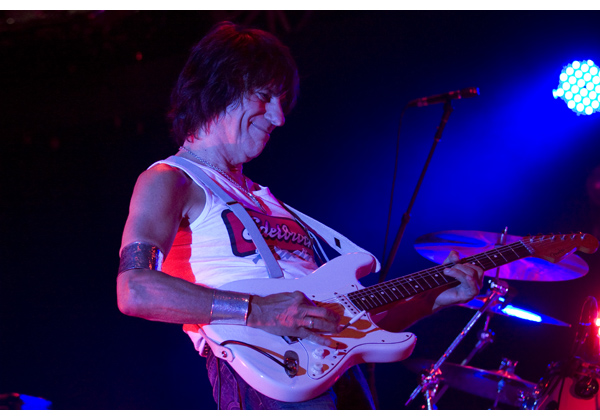
Three songs into the set, the master is starting to have a great time…
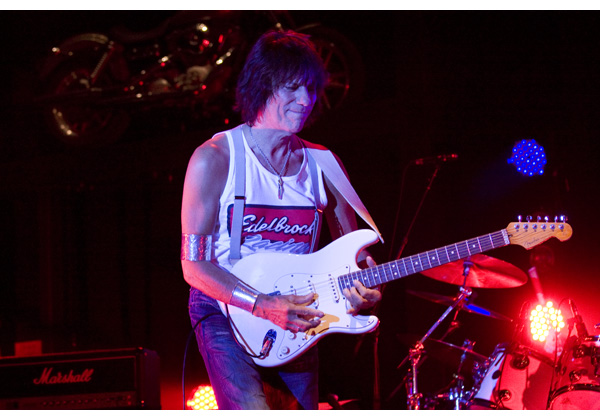
tom petty at Milwaukee’s Summerfest
There was no mistaking it for Bummerfest this evening…
Tom Petty and The Heartbreakers exploded onto the Marcus Ampitheather’s main stage and had the crowd up in arms. Music Editor Bob Gendron covers the show fully in issue 30 of TONEAudio, but here are a few extra photos for you. After a brief reschedule, the Heartbreakers’ tour is in full force for the rest of the year, so if you are a fan, grab some tickets, you won’t be disappointed.
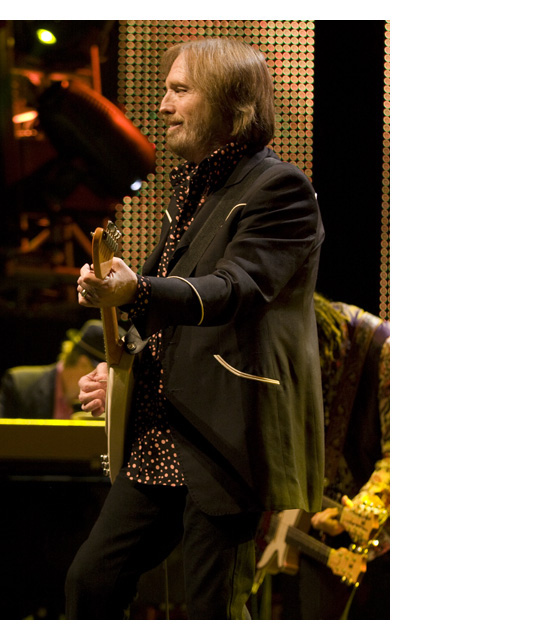
Both Petty and Mike Campbell had a great time changing guitars frequently….

And, what rock show would be complete without the double neck?
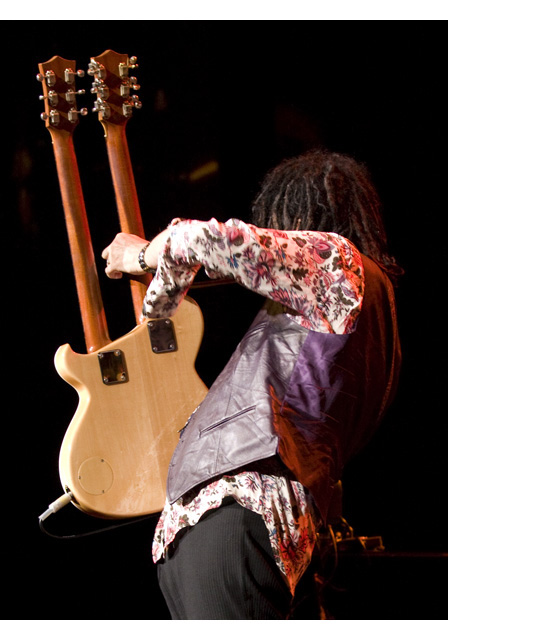
Getting on the download bandwagon
I have to say, I’ve been having a great time downloading high resolution digital files from Naim, HDtracks.com and others over the last few weeks. In case you haven’t noticed, we’ve added a new section for downloads right next to our audiophile pressings section in the magazine. With so much more music becoming available this way, it’s exciting to keep on top of it.
We’ll continue to expand this section going forward. Any suggestions, just drop us an email…
Conrad Johnson’s new ET3 preamplifier
The folks at C-J have just announced a replacement for their entry level “Classic” preamplifier, the ET-3. Utilizing much of what they’ve learned building their flagship GAT, the ET-3 is also a hybrid design, utilizing a 6922 tube and MOSFET follower.
Pricing has not yet been announced, but we are expecting it to be somewhere in the $2800 – $4000 range.
Watch for a full review as soon as we can get our hands on one!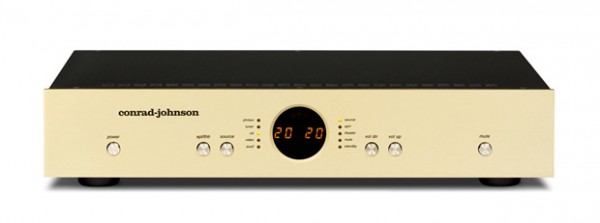
TONEAudio Magazine Issue 29
Features
The Rolling Stones: The Exile Super Deluxe Edition
By Bob Gendron
The Journeyman Audiophile: PrimaLuna ProLogue 1: Still Bitchin’
By Jeff Dorgay
Budget Gear: The Shunyata Hydra 2
By Jeff Dorgay
Old School Cassettes are still pretty cool
By Jeff Dorgay
Music Mastering The Art of the Transfer
By Steve Guttenberg
Tone Style
The B&W Zeppelin Mini
Nike’s Zoom Kobe V Shoes
Leica’s V-Lux 20
New Merch from Club Devo
The Flip MinioHD Video Recorder
Lexar’s Fastest Memory and Reader
Star Wars Cookie Cutters
Music
Live Music: The TONE Staff Covers Peter Gabriel, Ratt, Shelby Lynne, The Decemberists, Jonsi, Tegan and Sara and more…
Current Releases:
Fresh Releases in the Pop/Rock World
By the TONE Staff
Audiophile Pressings
The Velvet Underground, Sonic Youth, Yes and more.
By Jeff Dorgay
Jazz and Blues
By Richard Colburn
NEW! HD Downloads: Reviews and interviews with Peter Frampton and Gwyneth Herbert
By Jaan Uhelszki and Jeff Dorgay
Previews
Simaudio Moon 750 CD player/DAC
Naim HDX Music Server
The Squeezebox Touch
Reviews
Headphone Planet: Earbuds or Earduds?
By Bailey S. Barnard
Clearaudio Innovation Turntable and TT-2 Tonearm
By Jeff Dorgay
The Hegel H100 Integrated Amplifier and CDP2A CD Player
By By Jeff Dorgay
The J-Corder RS-1500
By Jeff Dorgay
The Electrocompaniet EMP-1M
By Jeff Dorgay
COVER: Naim’s UnitiQute
By Jeff Dorgay
The Dynaudio C4 Confidence Speakers
By Jeff Dorgay
The ZVOX 575 Soundbar
By Mark Marcantonio
SLUMMIN’
Sheet Music
Record store day almost here!
In case you didn’t know, Saturday, April 17 is Record Store Day. Record stores around the country will be having a lot of special merchandise in their stores, starting Saturday, and much of it in very limited supply.
We are launching some new record reviews over the next week, so stay tuned. And we have an interview with Wayne Coyne of the Flaming Lips as well.
Now get your butt over to your favorite record store on Saturday and show some support!
TONEAudio Magazine Issue 28
Features
The Stooges: Raw Power Just Won’t Quit
By Bob Gendron
The Journeyman Audiophile: The Octave V-40SE Amplifier: Refinement and Finesse
By Jeff Dorgay
Budget Gear: The DecWare Zen: Two of the Best Watts You’ll Ever Buy
By Jeff Dorgay
Time Warp: A Story of Cars, Cops and Slayer’s Decade of Aggression Live
By Bob Gendron
Tone Style
Ducati All Stars: Rockin the Roxy
The TONE Beer Snob: What You Should be Drinking
Apple’s iPad is the Future of…
The Steinway Lyngdorf System
The Quadraspire Q4EVO: A High Performance Rack That Won’t Break The Bank
More Goodies From Fred
Music
Live Music: The TONEStaff Covers John Mayer, Xiu Xiu and Kasey Anderson.
Current Releases:
Fresh Releases in the Pop/Rock World
By the TONE Staff
Audiophile Pressings
Jimi Hendrix, Humble Pie, Grant Green and more.
By Richard Colburn
The Music of Blaxploitation Cinema
By Anne Farnsworth
Previews
PS Audio’s Perfect Wave Transport and DAC
Acoustic Signature’s Analog One Turntable
Verity Audio’s Finn Speakers
Reviews
The Music Hall DAC25.2
By Marc Marcantonio
The Fosgometer
By Jeff Dorgay
The Meridian/Sooloos Control 10
By By Jeff Dorgay
Mark& Daniel’s Maximus Diamond+
By Mark Marcantonio
The PMC Fact 8 and Factory Tour
By Jeff Dorgay
The Manley Jumbo Shrimp Preamplifier
By Todd Sageser
The ZYX Omega X Cartridge
By Jeff Dorgay
SLUMMIN’
The Original iPod
Micromega’s Airstream Provides an Elegant Solution
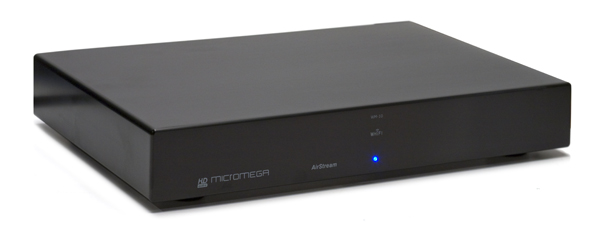 This is a controversial product to say the least. For many of you wanting to extend your digital music network, the $99 Apple Airport express is a great, low-cost way to add a pair of powered speakers somewhere into your environment. However, it is not an audiophile solution. At the other end of the spectrum, we have Micromega, with their $1,499 Airstream, which functionally does no more than the Apple Airport. We could have the same argument comparing the $300 Squeezebox to the $8,500 Sooloos music server. They both do the same thing, stream digital music files, but there’s more to the story.
This is a controversial product to say the least. For many of you wanting to extend your digital music network, the $99 Apple Airport express is a great, low-cost way to add a pair of powered speakers somewhere into your environment. However, it is not an audiophile solution. At the other end of the spectrum, we have Micromega, with their $1,499 Airstream, which functionally does no more than the Apple Airport. We could have the same argument comparing the $300 Squeezebox to the $8,500 Sooloos music server. They both do the same thing, stream digital music files, but there’s more to the story.
It is extremely difficult to use the Apple Airport Express in a non-Airport network environment. Personally, I’ve never been able to get one to integrate seamlessly in my own network, so for the duration of this review, I used a spare MacBookPro with about 300 mb of Apple Lossless, .wav and MP3 files for the duration of my test.
What’s in the box
The interesting paradox is that the Airport Express will probably need some support to make it work properly, and your chances of getting it are slim. If you purchase the Airstream from a Micromega dealer, your chances of getting dealer support are high, but you probably won’t need it. Next to the Sooloos, this is the easiest digital-music product I’ve ever used.
Setup is very easy. Plug the Airstream in any of your systems’ high-level inputs, turn it on and search for “Airstream” with your Mac or PC. It works well with either. If you are more adventuresome and have an AirPort-based network, you can use the AirPort Utility to change the address of the Airstream and make it join your existing Mac network. This might be handy if you have a large collection of music on a remote server somewhere that you’d like to access with the Airstream. I must admit, however, not feeling brave enough to be up to this task.
I found the easiest way to use the Airstream was to leave it in the stock configuration and use my MacBook Pro to control the music from my living room. That’s really the essence of the Airstream: keeping it simple. An added benefit of using the Airstream in this mode is that it isn’t taking bandwidth away from your primary network. In the past when using a laptop or Squeezebox on the same network as the rest of the house, it’s been easy to get dropouts in the music stream, should my daughter decide to download an episode of Family Guy in the middle of my favorite song. With music and computer data on separate channels, this is eliminated.
With your system set up in this manner, Micromega features an app that you can download to control all of this with your iPhone/iPod touch. For those with a remotely located server, this will make using the Airstream remotely even more fun. This will allow you the ease of controlling the Airstream from the bath tub, or wherever else you happen to be within its range. The iPod app makers I contacted all indicated that they have iPad apps soon to follow, so I anticipate using the Airstream via the iPad will be an oustanding music server environment.
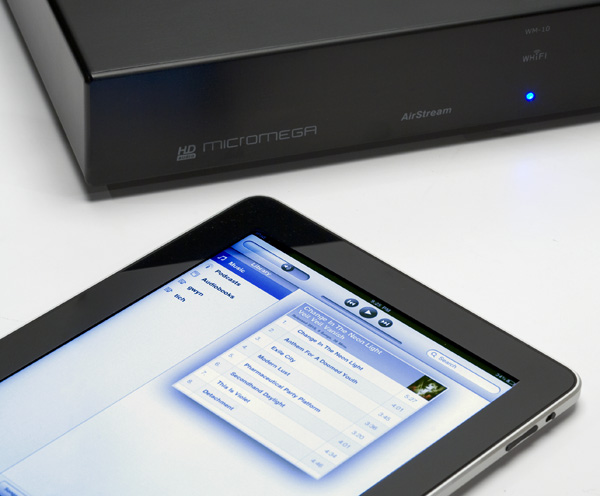
A sound improvement
Best of all, the difference between the sound of the Airstream and a standard AirPort Express is substantial. Just eliminating the switching mode power supply from the equation, by not having an AirPort Express anywhere near your system, is a big plus to start. The Airstream uses a much more expensive R-Core transformer and beefier analog power supply in addition to a custom designed digital processing clock that drives jitter specification errors dow to very low levels. Time bases jitter processing errors seem to be very audible to the brain; Micromega has 25-years of digital design experience and saw this obvious area for improvement. Putting the components in a proper box with RCA outputs also makes it easier to use the Airstream with an adequate pair of cables, rather than the eighth-inch mini jack from the AirPort Express. Eliminating the Ethernet connection also helps. Using the AirPort while running network data and a printer attached via USB makes for relatively lousy sound quality.
My only gripe regarding the Airstream is that I would have liked to see Micromega use a smaller case, something more like the size of a Naim HiCap power supply, for several reasons: it might have shaved a few bucks off the bottom line, it would free up more rack space, and it would look like there is more in the box.
However, a quick listening comparison reveals that there is a big difference in sound quality between the AirPort and the Airstream. There is a definite lack of graininess to the presentation that is present in the Airport, and more smoothness to the high end. I would draw a similar comparison to the difference in playback between my $85 Shure M97 and my $1,000 Lyra Dorian cartridges.
The native DAC inside the AirStream is a sophisticated Cirrus Logic 4344 24/192 design nestled inside a Marvell custom made chip-set that will allow native extended-bit conversion to be accomplished once Apple switches their iTunes music offerings over to high-res files. 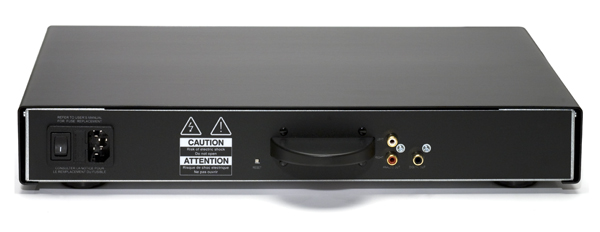
At present, because the Airstream relies on Apples Airtunes wireless transmission protocol, it will only play 16bit-44khz files native via iTunes and will downsample any high res files you might be collecting on your hard drive.
Is it for you?
Of course, the question on everyone’s mind is, “Is this thing worth $1,500?” Like everything, beauty (and convenience) is in the eye of the beholder. If you aren’t concerned with ultimate fidelity, you can probably get by with an Airport Express. But if you want a better sounding, more audiophile product, the Airstream is excellent. Designer Daniel Schar has 30 years of digital circuit design experience and it shows in the end result.
I see two standout scenarios for the Airstream, both of them good. Paired with your laptop or even a Mac Mini with a large hard drive, it could make for an excellent budget music-server system. If you are a network whiz, or have access to one, the Airstream could be an excellent remote client for a Sooloos, QSonix or other music server in another area of your home.
The bottom line is that if you want the convenience of using a product like this right now, with far better sound quality than the Airport can provide and that offers the convenience of fitting on your equipment rack, I think the Micromega Soundstream is a worthy product.
The Micromega Airstream
MSRP: $1,499
Manufacturer website: www.micromega-hifi.com
US/North America contact: www.audioplusservices.com
Enjoying the Apple iPad
While I’ve barely slept in the last 36 since the iPad arrived, we’ve all been putting it through its paces.
So far, it’s a winner. While it may be a laptop substitute for some, I think this device (like other Apple products before it) will define a new category of electronics. Read the full review below in the Spotlight section and let us know what you think.
The Wi-Fi only models, available in 16-64gb capacity are on most retailers shelves right now. Even if you aren’t buying today, you should stop by and check one out. But it might be tough to resist once it’s in your hot little hands. 3G models (requiring a seperate data plan, $30/month) will be available later in the month.
Magnepan 1.6
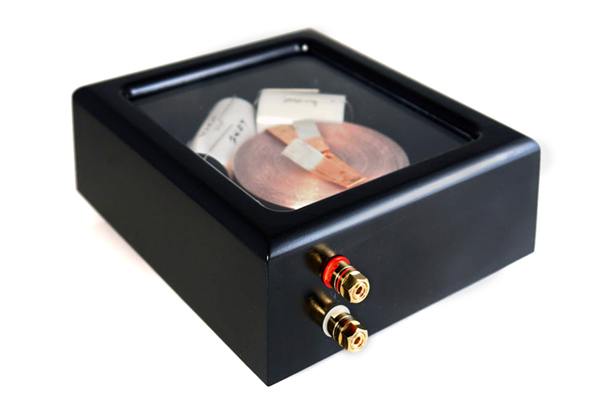 With Magnepan introducing their new 1.7 to replace the 1.6 that has been a staple of their line for about 15 years, many loyal Magnepan owners are probably asking themselves if they should make the move and upgrade to the latest. Knowing how slow Magnepan is (or perhaps cautious and conservative) with upgrades; there is certainly some promise on the horizon for this new speaker that will now feature a “quasi ribbon” driver for the bass panel as well. However, the original 1.6 is still a solid speaker with a lot of life left in it and let’s face it, who wants to sign up for shipping a hundred pounds and going through the audiogon hassle, right?
With Magnepan introducing their new 1.7 to replace the 1.6 that has been a staple of their line for about 15 years, many loyal Magnepan owners are probably asking themselves if they should make the move and upgrade to the latest. Knowing how slow Magnepan is (or perhaps cautious and conservative) with upgrades; there is certainly some promise on the horizon for this new speaker that will now feature a “quasi ribbon” driver for the bass panel as well. However, the original 1.6 is still a solid speaker with a lot of life left in it and let’s face it, who wants to sign up for shipping a hundred pounds and going through the audiogon hassle, right?
This hesitance by Magnepan to offer constant product updates is what has kept their resale high. A quick glimpse at Audiogon reveals that a used pair of 1.6’s can still command $1,200, though this will probably drop now that the 1.7’s are hitting the market. Considering a new pair would only set you back $1,699 at your local dealer, even if you paid retail, this is unheard of value.
But, audiophiles are like terriers, always sniffing around for something newer and better. I’m going to stick my neck out and guess that there are going to be a lot of used 1.6’s on the market for the next year or two and they will probably be a lot less than $1,200. Let’s face it, how many of you really want to deal with shipping these monsters, right? What if you could just easily improve what you already have, or perhaps score a great used pair of 1.6’s locally from someone who has lobsters in their pants, itching to buy 1.7’s?
Those of you that have 1.6’s are infinitely familiar with the speakers strengths: a big, big soundstage and exceptionally good upper bass performance along with perhaps the best coherence in the Magnepan line because they are only a two way speaker. The 1.6 also has its weaknesses, primarily the huge power requirements, limited dynamics and a haziness to the overall presentation compared to an electrostatic.
Pros and cons weighed in, if you have enough amplifier power, the Magnepan 1.6 is still one of the best values in high-end audio. But, there’s plenty of room for improvement, as we shall see.
Typically, I am not a fan of modding gear, but in a case like this where the basic engineering of the product is so robust, that swapping a few carefully chosen parts for ones of considerably higher quality, while not disturbing the original design ethos can take the product to a much higher level, I’m ready to get out the soldering iron. And that’s exactly what this mod does.
Enter the Ninja
Sean at the Skiing Ninja can take you to the next level of Magnepan performance, with his crossover upgrade. Taking the crossover out of the panel itself solves a few issues. No longer pinched by space requirements, the small external crossover abandons the relatively inexpensive parts used in the stock crossover and replaces them with copper foil inductors, Sonicap capacitors and a point to point wiring scheme. A pair of these gorgeous little boxes will only set you back $595 and is plug and play. 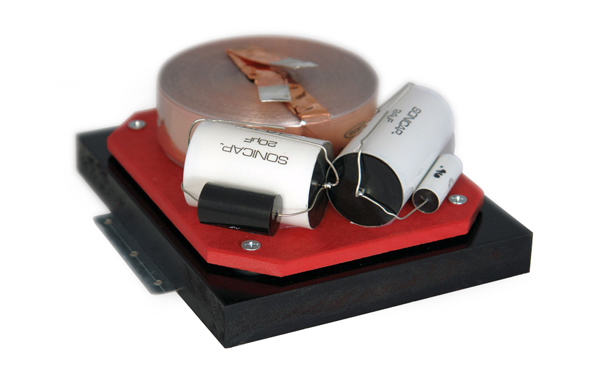
You will need to do a little bit of brain surgery, but you should be able to have the crossovers swapped in about an hour for both speakers. If you’ve never modified a piece of gear, you might be a little queasy about taking a pair of diagonal cutters to the crossover networks in your 1.6’s, but trust me, you’ll be glad you did.
The Ninja crossovers arrive in a tidy little box that is about 8 x 8 x 3 inches and can be ordered in a range of colors. I went for basic black and that worked just fine. You will have to remove the black panel that contains the fuse holder to get at the crossover inside. Of course this will void your warranty, but I’m guessing by now your speakers are out of warranty anyway. I also chose to abandon the original bi-wiring concept of the speakers, which I always felt was another weakness, requiring the pain of more banana plugs. Granted, many Magnepan owners swear by the bi-wiring method of connecting them, but the Ninja approach works much better and is much easier to attach decent speaker cable to.
Saying goodbye to the fuse felt a little scary, but again, the sonic gains outweigh the slight bit of protection the fuse offers. Just make sure you have plenty of clean power on tap… Once the old crossover is removed and the new one in place, via four spade lugs you are ready to roll.
A sonic revelation
Those big teflon capacitors will take about 500 hours to sound their best, so out of the box you will only notice a slight improvement in focus and midrange clarity, but at the 200 hour mark, the speakers sound like a blanket has been lifted from them, and they will improve steadily until about the 500 hour mark. To be sure I wasn’t just a victim of the placebo effect, I borrowed a friend’s stock 1.6’s so a direct comparison could be performed. Fortunately, the 1.6’s are pretty easy to move back and forth.
The improvements are substantial, but I found the biggest gain was in the midrange clarity. Now the 1.6’s were getting more into the electrostat range, with that haze in the original speaker a thing of the past. Playing your favorite vocal tracks will really bring this home. When listening to Johnny Cash’s “Delia’s Gone” from American Recordings, he goes from singing in the other room on the stock speakers to slightly in front of them, with much better separation between Cash’s vocal and his acoustic guitar. Same thing with John Hiatt on the title track of Slow Turnin, Hiatt’s voice comes right out of the mix where it had been somewhat buried in the past.
Though not quite as dramatic, as the capacitors break in, you will notice an even better blend between the woofer and tweeter panels, giving these speakers a higher degree of coherence. They sound a lot more like Quad 57’s (albeit much more robust ones) now in terms of the “midrange magic.”
As a result of this the mid/tweeter ribbon driver is less pronounced than in the past, giving everything from the midrange up less grain. It’s readily apparent, but having the originals handy made it that much easier to discern. Your favorite violin or piano disc should expose this immediately. I used the new disc from The Jung Trio on Groove Note records, Dvorak Trio in F Minor, Op. 65 and was amazed at how much more realistic the violins sounded, again thinking about my Quads while listening.
I had an equally satisfying experience when going through my favorite Keith Jarrett albums. The piano took on a more natural texture, with more nuance than before. It was much easier to hear the hall size when listening to the Sun Bear Concerts, thanks to an increase in low level detail, letting the piano’s notes fade off into the background with finer gradation than before. Again, a quick swap back to the stock speakers put things in perspective right away.
Last but not least, there is more texture in the lower bass region and even the upper bass speed is improved. The speaker just sounds faster overall with more bass weight and attack. A quick frequency sweep did not reveal the panel going any deeper, but the bass sounded more natural throughout the range. No, you still can’t play Snoop Dogg convincingly with the Ninja mods, but I’m guessing that isn’t why you bought Magnepans in the first place. Those of you that live on a steady diet of female vocal music will be spellbound by this increase in performance.
More of what you love with no guilt
Whether you’re a long term 1.6 owner who would like more performance, or someone who cashes in on the wave of people trading up to 1.7’s, the Skiing Ninja modified 1.6’s are a fantastic speaker, offering incredible performance at a bargain price. I wouldn’t be surprised if these even outperform the new 1.7’s. 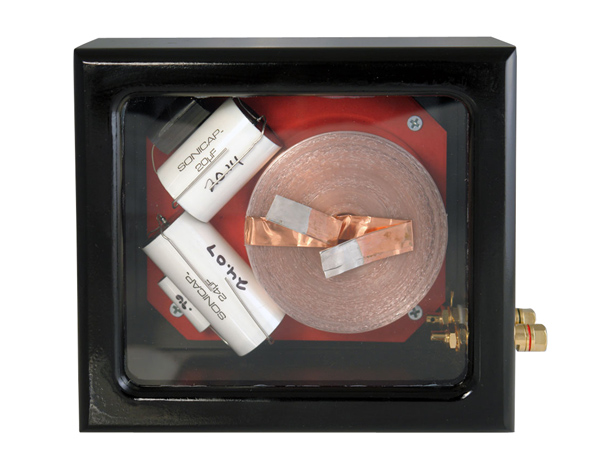
The Ninja mod builds on all the strengths of this speaker and has no drawbacks. Using the modded speakers with my reference McIntosh MC1.2KW’s, they consistently held their own in a six-figure reference system as long as I was listening to music that played to their strengths.
I can’t think of a better upgrade to a system based on a pair of these speakers for anywhere near $600. If anything, once you get the Ninja crossovers in place, you might be looking for a better/bigger amplifier to take advantage of the increased resolution. And cool cat that he is, the Ninja gives you 60 days to audition the mod with a money back guarantee. I can’t imagine anyone sending these back.
Highly recommended.
The Skiing Ninja Magenpan 1.6 mod
MSRP: $595
Peripherals
Analog Source TW Acustic Raven TWO turntable w/SME iV.Vi arm, Dynavector XV-1s cartridge and Nagra VPS phono preamp with VFS platform and Red Wine Audio Black Lightning power supply.
Digital Source Naim CD555
Preamplifier Burmester 011
Power Amplifier McIntosh MC1.2KW monoblocks
Cable Shunyata Aurora interconnects, Shunyata Stratos SP speaker cable
Power Running Springs Dmitri and Maxim power conditioners
CNET’s Music Awards Contest
CNET author (and TONEAudio contributor) Steve Guttenberg is sponsoring a contest for undiscovered talent.
While you won’t win as much cool stuff as you might on American Idol, you will get a great pair of headphones
from Monster Cable and some net airplay. Who knows where that will lead? Best of all, it’s a contest based
on sound quality as well as content.
So, fire up ProTools and get to work!
Here’s the link:
Digging the Paganini
It may sound like an exotic Italian snack treat, but it’s even better than that.
The Paganini is DCS’ latest four box digital player that consists of a CD/SACD transport, Master Clock, Upsampler and DAC. Yeah, it’s expensive, but it’s awesome. The good news is that you can build the system module by module, and if you are using computer based playback, you might not even want the transport.
But I’ll give you a hint, even with a tricked out dedicated computer for music, with all the latest greatest goodies, running Amarra, the spinning disc is still superior.
I’m off to the DCS factory on Monday to meet the brains behind the technology and it should be exciting.
TONEAudio Magazine Issue 27
Features
Old School: The Spica TC-50
By Jeff Dorgay
The Journeyman Audiophile: The PK-KI Amplifier: Another Rare Pearl From Marantz
By Jeff Dorgay
Budget Gear: The Naim Stageline: A Solid Performer
By Jerold O’Brien
Tone Style
The MartinLogan Custom Shop: A New Level Of Excellence
Hublot’s Depeche Mode Watches: Fight Teen Cancer, Buy a Watch!
From McDonalds to Mick Jagger: The Art of Jeff Ham
Cool Shooters from the House of Fred
The Waterfall Iguascu EVO: Transparent French Beauty
Hide Your Flat Screen With Help From Media Decor
Music
Live Music: The TONEStaff Covers Guns N’Roses, Chris Botti, Steve Earle and City and Colour.
Current Releases:
Fresh Releases in the Pop/Rock World
By the TONE Staff
Audiophile Pressings Presented by Music Direct
The Bad Plus, Johnny Hartman, The Flaming Lips and more.
Four New Releases From ECM:
Selections From the Six Degrees Catalog
By Richard Colburn
Previews
Apple’s New iPad
YZX Omega X Phono Cartridge
MartinLogan’s Motion 4’s
The J-Corder Technics 1500
Reviews
Headphone Planet: One to Keep, Two to Toss
By Jeff Dorgay
The Snell K-7’s
By Jerold O’Brien
YG Acoustics Anat II Studio
By Jeff Dorgay
KEF xQ-20
By By Jerold O’Brien
Mark& Daniel’s Maximus Diamond+
By Mark Marcantonio
Penaudio’s Rebel 3’s
By Steve Guttenberg
ERA Design 5
By Rich Kent
SLUMMIN’
The Garrard Zero 100
Record Cleaning For Fanatics
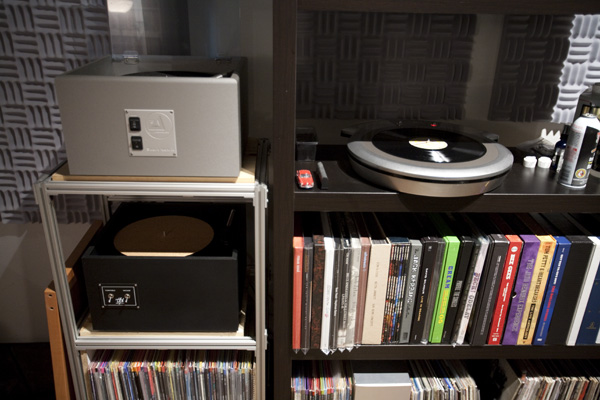 Just drop by any internet forum and you can make enemies instantly by bringing up the subject of record cleaning. LIke every other aspect of the HiFi hobby/obsession, you can do this on a few different levels, and your budget can determine the results. I’ve seen plenty of DIY ways to clean records (with most of them ending in tears, or at least ruined records), but nothing that works consistently or convincingly.
Just drop by any internet forum and you can make enemies instantly by bringing up the subject of record cleaning. LIke every other aspect of the HiFi hobby/obsession, you can do this on a few different levels, and your budget can determine the results. I’ve seen plenty of DIY ways to clean records (with most of them ending in tears, or at least ruined records), but nothing that works consistently or convincingly.
After years of screwing around with this myself, here’s a method that works. You don’t necessarily need two record cleaning machines, but I admit I’m obsessed and it really makes the job move more quickly. If you don’t use two machines, at least try and use a machine like the VPI 16.5 or Clearaudio Smart Matrix that allows you to swap cleaning wands, so that you aren’t cleaning overly dirty records with the same surface that touches your brand new (or nearly new) records.
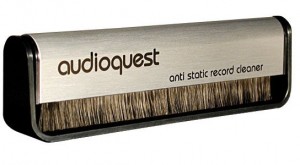
Here’s an extra step that will make the record cleaning machine’s job easier. Start with a carbon fiber brush like the Audioquest one shown here and go around your record in a circular motion, almost like sweeping the dust up on the floor to the center of the record.
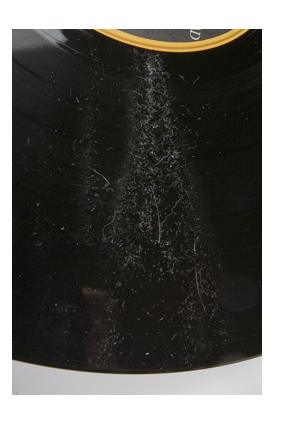 See that gigantic pile of dirt? Grab a handy can of compressed air and blow that right off the record. This will make it that much easier for your RCM to get right at the tough dirt and it cuts down on the crud that sticks to the cleaning pads.
See that gigantic pile of dirt? Grab a handy can of compressed air and blow that right off the record. This will make it that much easier for your RCM to get right at the tough dirt and it cuts down on the crud that sticks to the cleaning pads.
Getting down to business
For now, we’re going to assume you are cleaning a record that is somewhere between brand new and moderately dirty. My favorite all around cleaner for records in this state is the MoFi Enzyme cleaner. The directions specify leaving this on your record for 60 seconds, but if you have a fairly dirty (and possibly fingerprinted) record, apply a heavy dose of fluid and let it soak for five minutes. Otherwise, if only moderately dirty, go with 60 seconds. Once done soaking, give your record cleaner a spin and vacuum up the grime. The reason I prefer the Clearaudio Smart Matrix RCM is its ability to clean in two directions, which is very helpful if you have a moderately to very dirty record. So, if you have an extremely dirty record or are just paranoid, apply the cleaner one more time and spin the record the other way, vacuuming as you go.
You’re almost home, but don’t let your excitement get the best of you. Even the best RCM’s leave a bit of cleaner residue on the record’s surface, which will eventually require a re-clean and will accumulate on your stylus. That’s not good in either case, so we’re going to take this one step further and use MoFi’s Pure Record Rinse, and vacuum our record one more time.
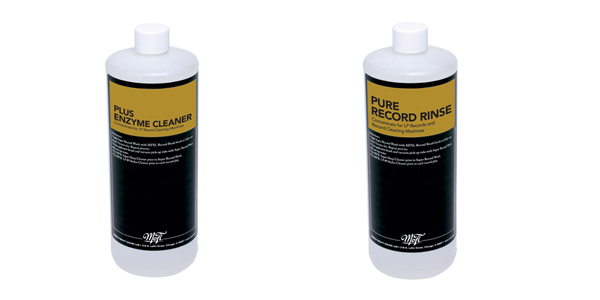
Home Stretch/Bonus Round
Once you’ve done all of this, take that compressed air and make one more pass, to make sure that record is completely dry before our next step. For most of you, this will be the point that you either put that super clean record in a fresh sleeve or take it for a spin to marvel at your cleaning prowess. But if you’re really a maniac, gently place that record on the Furutech DeMag and zap it for 45 seconds. Again, we can argue about this until the cows come home, but the bottom line is this gadget that looks like a prop from the first season of Lost In Space really works. It will take that last bit of grain and harshness from the presentation.
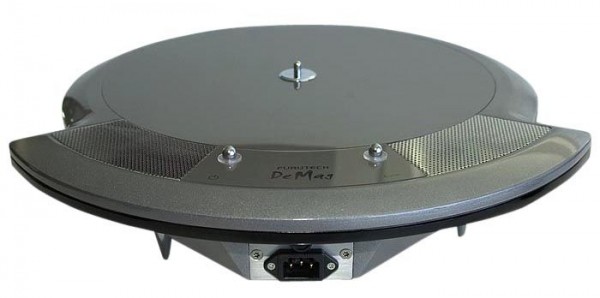
Now put the record on your turntable, relax and enjoy. If you’ve followed the steps carefully and the record has no surface damage, you should be enjoying analog playback that rivals a CD in quietness. No more of that “vintage sound, consisting of clicks and pops” that the mainstream press likes to go on and on about whenever they talk about the vinyl resurgence. This is the analog magic at it’s best.
While there are a number of different cleaning solutions, cleaners and brushes, I guarantee this process will work. And while I’m a fanatic, I’m lazy. I use this combination because I can get it all from one place (Music Direct) and they always have it in stock. Feel free to experiment as you get comfortable, there are a few more variations on the theme, but only if you are even more fanatical than I am.
And by the way, is that turntable level? Just checking!
Alan holdsworth show
Hardly, but I’ll get to that in a moment. It seems like the Publisher and I are starting a tradition. Either wait in bitter cold for a concert or wait in cold and rain. So we dutifully waited forty minutes in the rain for the door of the Aladdin Theater to open so that we could see the Bozzio, Holdsworth, Levin, Mastelotto band in action. For the record, it was a sellout and then some.
Looking as the resumes of the players and perusing their resumes, one would expect something in the jazz/art-rock/fusion vein from them. Moreover, once I saw the lineup, I expected some pretty excellent musical pyrotechnics and was really in the mood for a gigantic fusion slap on the side of my head. Instead, what we got was two thirty five minute sets of relatively tame meandering.
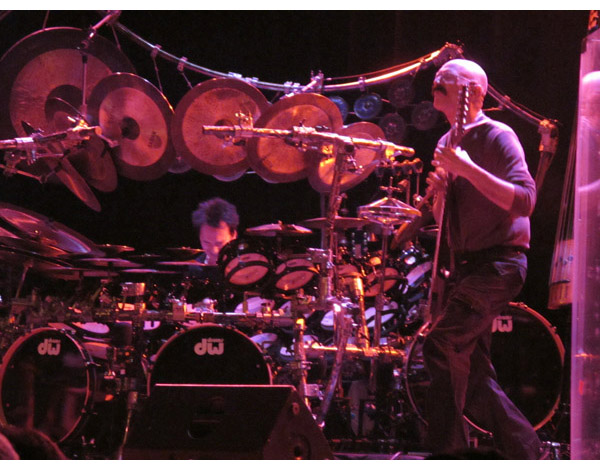
With Terry Bozzio and Pat Mastelotto in attendance, you get varied and intense percussion no matter what material is being played. And the complex rhythms and sinewy interaction between these two was superb. Tony Levin provided subterranean bass lines via his five string electric upright or Chapman Stick. Occasionally he’d climb the registers and do some spontaneous soloing, but otherwise it was bedrock bass. Allan Holdsworth was the perfect example of admirable restraint. Given the free-from nature of the two sets, he could have wandered into wretched excess, but on the whole he wove complex often mournful sounds into the fabric of the music.
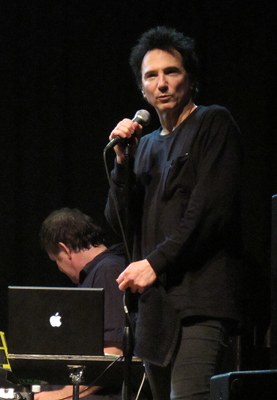 Even though the audience was a bit nonplussed by the performance, the musicians were strong enough to pull off the unexpected in a commanding fashion. I guess one could sum the evening up in Bozzio’s own words at the onset of intermission: “It’s obvious we don’t have any prepared material tonight. Think of what we are doing as though it were an instant soundtrack.”
Even though the audience was a bit nonplussed by the performance, the musicians were strong enough to pull off the unexpected in a commanding fashion. I guess one could sum the evening up in Bozzio’s own words at the onset of intermission: “It’s obvious we don’t have any prepared material tonight. Think of what we are doing as though it were an instant soundtrack.”
Benchmark DAC-1HDR
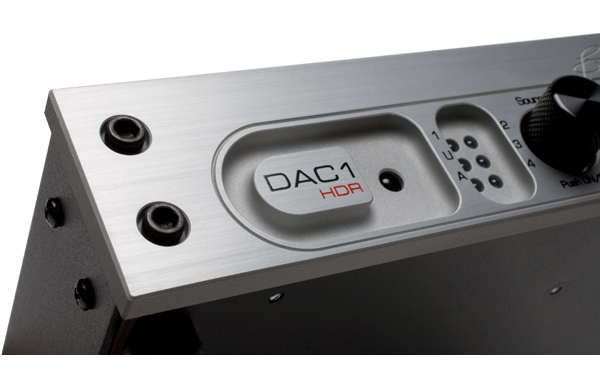
All the way back in issue three of TONEAudio, we gave the original Benchmark DAC-1 our first Exceptional Value Award. Through the years, they’ve continued improving this diminutive yet highly powerful piece of audio gear and even though it has gone up in price from $995 when we first reviewed it to $1,895 today it offers a lot more under the hood. Amazingly enough, Benchmark’s engineers have managed to squeeze it all into the original box, so on the outside it looks pretty much the same. For those of you just needing the basic DAC and headphone amplifier, you can still buy the original DAC-1 for the same price of $995. That’s pretty awesome, considering our wacky economic times.
What made the DAC-1 such a great value was the addition of an outstanding headphone amplifier to the package. You’d easily have to spend $400-600 to get this kind of performance with an outboard headphone amplifier and you’d need more cables, etc. The DAC-1 has always included the option of fixed or variable outputs, which has always made it very handy as a linestage in a pinch, or as the cornerstone of a compact, yet high performance audio system. Then, as now, I still can’t think of a product that does more in less space than the Benchmark DAC-1, no matter what version you choose.
A quick history refresher
If you’ve followed the progress of the DAC-1, it originally offered coaxial, XLR and optical digital inputs along with a pair of RCA and XLR outputs. But, we audiophiles always want more and as more people started to use laptops as music sources, Benchmark answered the call and provided the DAC-1 USB, with a USB input. I had mentioned in my review of the DAC-1 USB that this would be the perfect combination if it only had an analog input, so that this could truly be used as a front-end component for that music lover that enjoyed analog as well as digital sources and the DAC-1 PRE was born, featuring an analog input.
They’ve been reading my mind
As cool as the DAC-1 PRE was, I began thinking “now if it only had a remote control…” and before you know it, we now have the DAC-1 PRE. This unit includes the recent op amp upgrades to the last few rounds of the DAC-1, featuring high current LM4562 op amps in every step of the analog path. Comparing the current DAC-1 HDR to the original DAC-1 reveals slightly less grain than the already good original, when playing them side-by-side in my reference system.
However the big change, along with the remote control is the addition of a custom, motorized ALPS volume control. It offered very smooth operation from the remote and perhaps replacing the original volume pot with the ALPS version accounted for a little of that added smoothness. Now the DAC-1 HDR is the perfect compact linestage/headphone preamp/DAC combination. Hmmm, maybe they’ll add a couple of triode tubes to the output stage next? Or a phono preamp? Let’s see those guys at Benchmark squeeze that one in that tiny case!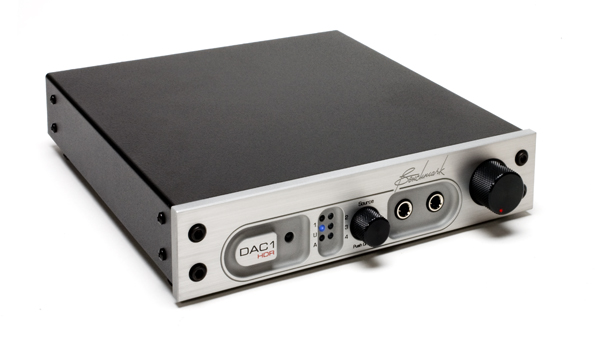
But seriously
All kidding about vacuum tubes aside, the DAC-1 HDR does a fantastic job with its core technologies. As I said, I made it a point to compare the original to the current model and there is definitely a slight advantage to the latest in regards to smoothness in the treble register.
The strength of the DAC-1 HDR is that it is such a great all around piece. If you are just looking for a DAC or don’t need the analog input, save the money and grab the original DAC-1 or DAC-1 USB.
The sound of the Benchmark as a DAC overall is very neutral and dynamic. While it lacks the bass slam or smoothness of my Wadia 781SE or the new Simaudio Moon 750 that I’ve spent a lot of time listening to, these units cost 7-10 times what the Benchmark does. Regardless of what the measurement geeks want to tell you, there’s more to the sound of a DAC than the bits and you won’t get a $10,000 DAC for a $1,000.
However, the Benchmark still stacks up very well against its similarly priced competitors, offering a neutral midrange, solid bass performance and some airiness to the presentation. What makes it outstanding is the other functions it performs without needing additional interconnects or power cords.
Another extremely cool feature of the DAC-1 HDR is the pair of balanced analog outputs. This allows you to keep the DAC 1-HDR up on a shelf, perhaps with a music server, etc and run a long pair of balanced cables to a power amplifier elsewhere in the room. Which is precisely what I did, pairing the DAC-1 HDR with a few different amplifiers; the McIntosh MC275 (tubes), the Nagra PSA (solid state) and the BAT VK-55SE (tubes). Equally impressive was the DAC-1 HDR’s ability to drive a pair of 20 foot RCA cables as well. This is certainly a very robust output stage!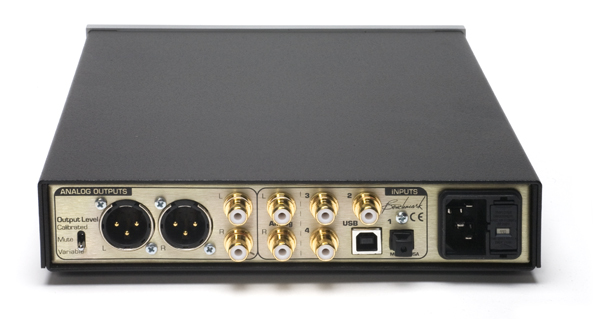
A superb line stage
Making the DAC-1 HDR the hub of my test system worked well when I added my Technics SL-1200 with Sound HiFi mods and SME tonearm to the mix, along with the Simaudio Moon LP 5.3 phono preamplifier. Digital sources were a Sooloos music server via S/PDIF input and my MacBook Pro via USB.
The Benchmark had no problems playing high res files from either source and recognized the MacBook and a windows Netbook with no glitches whatsoever. I also made it a point to try the TOSLINK connection, with no problem. Gone from the original DAC-1 is the XLR digital input, so if you are one of the rare users that need this for your transport, you will be out of luck on the DAC-1 HDR
The sound of the line stage is just like the analog stage of the DAC; clean, dynamic and neutral. Similar to many of the op amp based preamplifiers I’ve heard, there is a similarity in the sense that an ultimate sense of “airiness” is not present. You can only cram so much into a tiny box and in the Benchmark’s defense, the $3,500 Classe preamplifier I auditioned last year that was full of op amps (and did not have a DAC or headphone amp inside) sounded no better, it’s just the nature of the beast.
Great news for headphone lovers
I’m not sure what I like better about the DAC-1 HDR, the DAC, or the headphone amplifier. Using the new Sennheiser HD-800’s as well as my HD650’s with Stefan Audio Art Cables and AKG 701’s with ALO Audio cabling, I always had a great time listening to my headphones. The DAC-1 HDR spent a fair amount of time in my bedroom system with the Wadia 170i and an iPod full of uncompressed files.
The stereo image provided by the DAC-1 was very wide and the bass performance with the HD650’s and HD800’s was very powerful. The DAC-1 also did a great job at driving the AKG 701’s, which is notoriously tough to drive. If you are primarily a headphone user that would like to build a system around one box (two if you have a turntable) the DAC-1 HDR will be a perfect match for the space limited audiophile that still wants great sound.
Much more than the sum of its parts
If you break it down, the Benchmark DAC-1 HDR is essentially a $700 linestage, a $700 DAC and a $500 headphone amplifier. The sound quality and resolution of each stage compares favorably, comparing each section of the DAC-1 HDR to individual components easily costing twice as much. Back $300-500 out of that price for even the least expensive interconnects and power cords, and this is a value that just can’t be beat.
Again, I am proud to give the latest version of Benchmark’s DAC-1 one of our Exceptional Value Awards for 2010. This is a fantastic anchor to a system in the $4,000 – $10,000 range and one that you will have to pay quite a bit more money to outgrow.
-Jeff Dorgay
The Benchmark DAC-1 HDR
MSRP: $1,895
Manufacturers website:
http://www.benchmarkmedia.com
Peripherals
Analog source Technics SL-1200 w/Sound HiFi Mods, SME 309 Toneram, Simaudio Moon LP 5.3 preamplifier and Lyra Dorian cartridge
Digital sources Sooloos music server, Wadia 170i, McIntosh MCD500 (as transport)
Amplifiers McIntosh MC275, Nagra PSA, BAT VK-55SE, Moscode 402au
Cable Shunyata Aurora, Cardas Golden Reference
Power Running Springs Haley, RSA Mongoose power cord
More TONEAudio Magazine in 2010!
That’s right folks, you keep asking us for more content and we deliver. Starting with the Feb. 10 issue of TONEAudio, #27, we will be going to a full 8 issue schedule, publishing every 6-7 weeks. We will also be changing our format from the square you’ve known for the last five years to a more standard, 8 1/2 x 11 inch vertical format.
Why you ask? With the proliferation of eBook readers, and most importantly, the Apple iPad, we’re formatting TONEAudio so that it’s an easier read for our mobile audience. Those of you reading TONEAudio on your laptop will now be able to have the issue fill the whole screen when you read it in two-page mode.
When the Issue #27 is released, it will be in our standard resolution and high resolution formats, with a third version in ePub format to follow shortly after. As soon as we can transfer them, we will also make our back issues available in ePub format, albeit still in their original square formats.
We hope you enjoy the new format and for those of you becoming early adopters of the iPad, will download it to your newest toy.
CES 2010 – Day 1
Spent most of the day in meetings finding new goodies for upcoming TONEAudio reviews, but the two most intriguing things I did see for the day were both small.
Naim announced their new UnitiQute (pronounced “Unity-Q”) in Vegas for the world to see and it is a brilliant product. Fashioned after the outstanding Uniti that won our product of the year award in 2009, it takes a slightly smaller power amplifier than the Uniti (30 wpc vs. 50) and eliminates the CD drive.
The remaining tiny box still provides a full function integrated amplifier, 24/96 DAC, FM tuner and internet radio access as well as being able to stream digital music from your Naim HDX or network server. All in a package about the size of a Nait 2.
And, the price is small too! $1,995 will put one of these little jewels in your living room or wherever you’d like to put it. I have no doubt that this will be one of the hottest selling products of 2010. Watch for a full review asap.
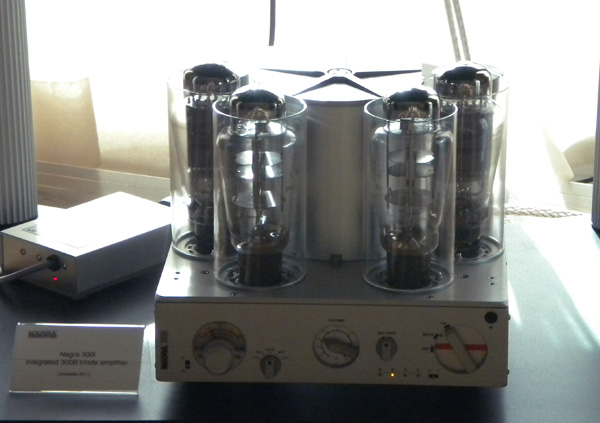
The other small but mighty surprise was in the Nagra room, where they were showing off their newest power amplifier with a pair of 300B output tubes, driving a pair of Verity Leonore speakers.
I saw these first being built on my trip to Nagra this summer and while according to US importer John Quick, they are still a year from production, if you are a fan of the 300B, this amplifier is worth the wait. Nagra has done a fantastic job here! Stay tuned….
TONEAudio Magazine 26
Features
Old School: The Mark Levinson no.23 Power Amplifier
By Jerold O’Brien
The Journeyman Audiophile: Paradigm Studio 60v.5 Speakers
By Mark Marcantonio
Budget Gear: The Devilsound DAC
By Jerold O’Brien
Mark Mothersbaugh: Almost Everything You Want to Know
By Jaan Uhelszki
Rolling with the Stones:
By Ben Fong-Torres
High Style and Functionality A Visit to B&O and review of the BeoSound 5
By Jeff Dorgay
Swiss Performance The Nagra LB Mastering Recorder and a Visit to the Nagra FactoryBy Jeff Dorgay
Dealers That Mean Business: We Visit TomTom Audio in the UK
By Jeff Dorgay
Tone Style
The Canon G11 Compact
Audiophile T-Shirts from Friend or Foe
Greener Screen Cleaner
The Aston Martin Cygnet
The Olympus LS-10 Digital Recorder
XBox Boxer Shorts
Smiley face wine
Music
Live Music: The TONEStaff Covers Bruce Springsteen and Stanley Clarke.
Current Releases:
Fresh Releases in the Pop/Rock World
By the TONE Staff
Audiophile Pressings Presented by Music Direct
Devo, Blue Note on XRCD, Jeff Beck and more.
Club Mix:
Exploring French Music
By Scott Tetzlaff
Previews
Burmester’s 911 mk.3
The McCormack DNA-750 Monoblocks
The Naim HDX Music Server
The WinAnalog SET Monoblocks
Reviews
Headphone Planet
By Bailey S. Bernard
The McIntosh MC 1.2KW’s
Major Muscle
By Jeff Dorgay
The Simaudio Moon W7M monoblocks
By Jeff Dorgay
JL Audio’s Gotham: The Ultimate Subwoofer
By Jacob Heilbrunn and Jeff Dorgay
Perfection: The Burmester 911 MK.3 Amplifier
By Jeff Dorgay
The daRTzeel CTH-8550 Integrated Amplifier
By Jeff Dorgay
The Rega Osiris Integrated Amplifier
By Jeff Dorgay
SLUMMIN’
Classics on the cheap
Red Wine Audio Black Lightning DC Power Supply
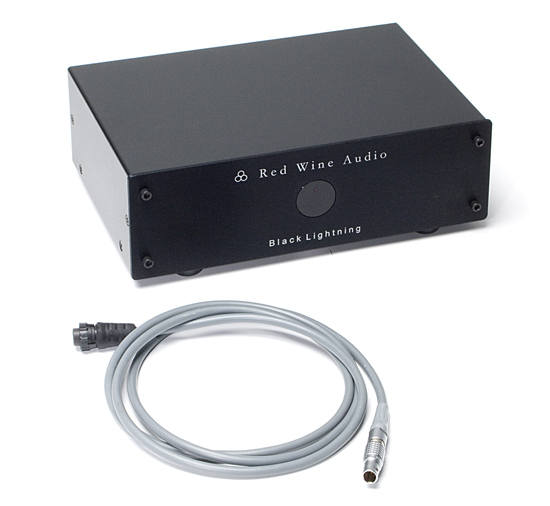 By Jeff Dorgay
By Jeff Dorgay
If you’ve been reading TONEAudio for the last couple of years, you know I’m a big fan of the battery-powered gear from Red Wine Audio, built by Vinnie Rossi and his team. I’ve used their Signature 30.2 power amplifiers and their Isabella tube preamplifier with excellent results. The key to a large part of these components success is the fact that they are powered “off-the-grid” from high-current, sealed lead-acid (SLA) batteries, and Red Wine Audio has made the them effortless to use thanks to their SMART charging system.
The great thing about SLA batteries is that they have very low impedance (very high output current capability) and relatively flat discharge characteristics. The benefit to you is that the sound does not change as the batteries begin to discharge, and dynamics are maximized. I’ve used a number of battery-powered components, and the ones that rely on normal alkaline batteries (the Sutherland PH3D and Chord preamps come to mind) change their sound dramatically over the charge period and don’t have the low output impedance. The result is a sound you can’t really get used to.
SLA batteries are much better in this application, but they do require a certain amount of care to keep them performing at their peak, but who’s got time for that? What Red Wine Audio has done with their new SMART (SLA battery Monitoring and Auto Recharge circuit) board is to make the battery process a “no fuss, no muss” affair. Everything works in the background, so you only need to concentrate on the music. When the battery voltage discharges down to a set level (which is continuously monitored via the SMART board), the SMART circuit automatically turns OFF the unit and begins the recharge process for you. In addition to being very convenient, it maximizes battery life by avoiding accidentally deep-discharging the SLA batteries.
There are three other very important features worth mentioning about the Black Lightning: First, when you are using battery operation, the charging circuit is completely disengaged from the batteries, so there is no chance of noise leaking into the power supply. The battery charger itself is a separate unit that plugs into the Black Lighting for total isolation.
Second, the Black Lightning has 0.5 second in-rush current limiting avoid the high current in-rush that you don’t typically see with conventional AC power adapters because they cannot supply nearly the same level of output current. According to Vinnie, it’s actually better to leave your component switched on all the time and use the power switch on the Black Lightning as your power switch, thus always allowing “soft starts” of your audio component – which prolongs the life of their internal components.
Third, and possibly most important, I have to believe that while a good portion of the Black Lightning’s improvement comes from removing your audio component from the grid, it also eliminates one or more switching power supplies from proximity to your system. Anything in your HiFi system that uses a “wall wart” power supply is a noise bandit, dumping a healthy amount of RFI back into your power line and associated components. Even with world-class power line conditioning, I noticed a slight decrease in background noise with my other components, having eliminated the two switching power supplies from my system.
Red Wine brings this technology to the rest of us
As cool as the idea of getting off the grid is, for most power amplifiers, it’s not practical because of the high voltage requirements. But for preamplifiers, phonostages, dacs, and other low-level components that accept DC input voltages from AC wall adapters, Black Lightning will elevate the performance of your components to a whole new level. The minute you leave the grid, you’re leaving any AC-related noise and distortion components behind completely.
Earlier this summer, Vinnie and I were discussing exactly this and I asked him if he could build an upgraded 12Vdc power supply for my Nagra VPS phono preamplifier. I’d like to think I had a small hand in the process and in November, the Black Lightning was born. There are two models to choose from, the Series 10 and the Series 12. The main differences between them are the available output voltages and their current capacity (measured in Amp-Hours), which translates into the ability to power a component that draws more current for a longer period of time.
You can read the full list of configurable options here:
http://www.redwineaudio.com/products/black-lightning
The Series 10 starts at $625 and the Series 12 starts at $825. When you think about it, that’s just about what a good power cord would set you back. Hmmm. My review centers around three components that I felt would respond very well to being removed from the grid and that accepted a 12Vdc input (which I had Red Wine Audio configure a Series 10 unit for me); the Nagra VPS phono stage, the Nagra LB portable digital recorder and the Wadia 170i iPod dock.
Across the board gains
The $9,000 Nagra VPS/VFS phono stage has been my reference for over a year now and is a hybrid tube/solid state design. I’ve been very satisfied with the VPS/VFS, but it’s always had the slightest bit of background noise and hum that I’ve just chalked up to life with tubes.
Immediately after plugging the Black Lightning in, all of the noise was gone, even when sticking my ear right up to the tweeter. The Black Lightning redefines the term “inky black background.” The big surprise was when I set the stylus down on the first record, Neil Young’s Live at Massey Hall. (200g. Classic Records version) We gave this record one of our product of the year awards in the audiophile recordings category. If you have this record, you know how big the soundstage is, but adding the Black Lightning just blew the boundaries out of my room. The Nagra’s already excellent dynamics went up a few solid notches. It just wasn’t the same preamplifier anymore. Everything I loved remained, but now it was super sized!
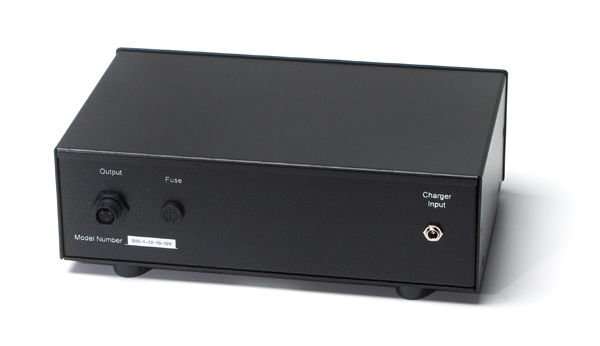 I am a big believer in clean power, and the validity of good power cords, but I’ve never had this much improvement from any power cord or line conditioner. I currently use the Running Springs Dmitri line conditioner on the front end of my system (and a Running Springs Maxim on a separate 20 amp line for my power amplifier) and I feel this product is the top of the mountain in power line conditioning products. I would compare the difference plugging the Nagra into the Black Lightning to be an equivalent jump in performance I experienced when I plugged the rest of my system into the Dmitri from the wall. Background noise decreased dramatically, dynamics increased substantially and the upper registers got smoother, yet more defined.
I am a big believer in clean power, and the validity of good power cords, but I’ve never had this much improvement from any power cord or line conditioner. I currently use the Running Springs Dmitri line conditioner on the front end of my system (and a Running Springs Maxim on a separate 20 amp line for my power amplifier) and I feel this product is the top of the mountain in power line conditioning products. I would compare the difference plugging the Nagra into the Black Lightning to be an equivalent jump in performance I experienced when I plugged the rest of my system into the Dmitri from the wall. Background noise decreased dramatically, dynamics increased substantially and the upper registers got smoother, yet more defined.
The more records I played with the new “upgraded” Nagra, the more impressed I was with the contribution of the Black Lightning supply. The effect was all positive and not the least bit negative. The bass drive had increased substantially, as if I had added a subwoofer to the system!
As much fun as the additional bass grunt was, this already detailed phono preamplifier was considerably better with microdynamics than before. No matter what kind of music I was listening to, I was always able to hear further into the recordings than I could before, thanks to the lower noise floor. This also gave my system the added benefit of sounding “louder” even at low volumes because the effective dynamic range was increased.
I’d also like to mention that when Vinnie and I were discussing playback times as he was developing the Black Lightning, I was expecting about 4 hours worth of playback time with the Nagra VPS (based on its power consumption rating) and I’m getting about 8 hours consistently. Very impressive!
Benefits with other devices as well
I had similar results with the Wadia iTransport dock, and this was very easy to discern using the Wadia 781i as my DAC. Everything was decidedly “less digital” sounding and the gap between .wav files on my iPod and the CD played on the Wadia closed further.
When using the Black Lightning with my Nagra LB digital recorder that is already battery powered by AA batteries, the main difference when using the Black Lightning SLA battery supply was slightly increased dynamics, better resolution during lower level passages and much longer record time. The LB will eat up eight AA cells in pretty short order, and with the Black Lightning I was able to record all day long without stopping to recharge. Again, the added benefit here with a Black Lightning is that you aren’t tossing a pile of Duracell’s (that contain mercury) in to the wastebasket on a regular basis. Better sound and better for the environment.
A product that truly exceeds expectations
In the world of high-end audio, there are a lot of snake oil vendors and precious little science and engineering, with every new widget promising nirvana where none previously existed. Red Wine Audio’s Black Lightning power supply is well-built, with solid engineering behind it and does a fantastic job at its designated task. You can’t ask any more from a component!
If you have something in your system that uses a switched mode/wall wart power supply and feeds a DC output voltage to your component, the sonic benefits you will receive from the Black Lightning will be instantly apparent. It has certainly made a welcome addition to my reference system. Give Vinnie a call to see if he has one that will suit your needs.
The Red Wine Audio Black Lightning, $650 – (approx.) $1,000 depending on size and configuration.
32 Ohm Audio Grand Opening
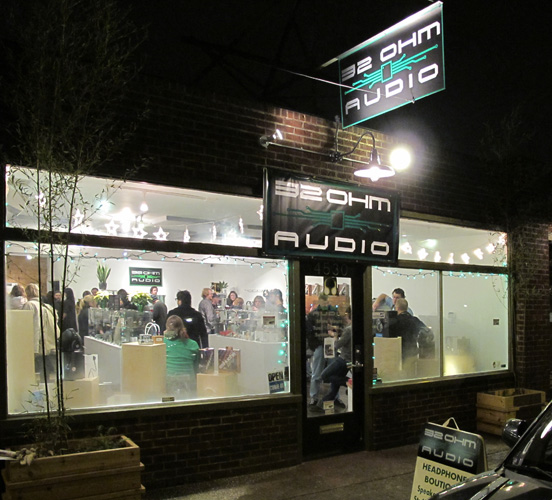 While CNN and Fox News are both presenting their own version of the economic collapse, the Christmas shopping season is alive and well here in Portland, Oregon at the world’s first exclusive headphone boutique, 32 Ohm Audio. I know nothing warms my heart like seeing people out in force, buying audio gear!
While CNN and Fox News are both presenting their own version of the economic collapse, the Christmas shopping season is alive and well here in Portland, Oregon at the world’s first exclusive headphone boutique, 32 Ohm Audio. I know nothing warms my heart like seeing people out in force, buying audio gear!
Shop owner Ken Ball said the store had been packed all day and by the time I arrived on the scene at 8p.m. the party was still hopping. In addition to the helpful store staff they had drinks, munchies and had enlisted the help of local DJ Lady Adie who was spinning analog and digital tunes.
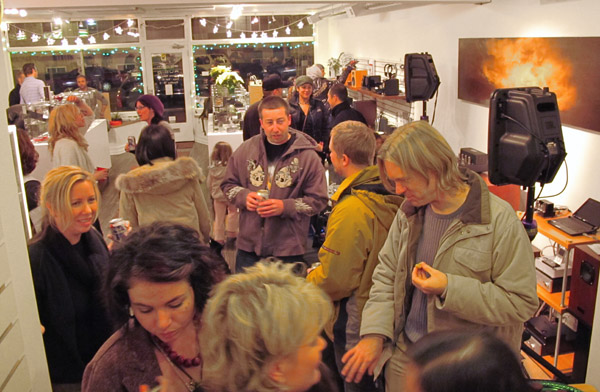
In addition to the festive atmosphere, thanks to their vendors, quite a few prizes were given away. Headphones from Monster and Ultrasone, along with a wireless iPod dock from Ultimate Audio had the fans jumping when I was there. One person in the crowd said, “These are some pretty impressive prizes, not like most places that give away drink holders!”
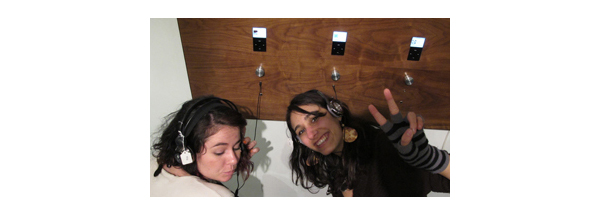
But in the end the winning formula is customer service and a wide product range. Ball said, “Buying headphones is such a personal thing, you really need to hear them before you purchase. We’ve got a wider selection than anyone and the atmosphere here is very chill. We want people to have fun when they come here.”
I think that says it all. When you are in Portland, stop down and see the crew at 32 Ohm Audio, you’ll be glad you did.
Julian Lennon’s New EP
Julian Lennon and James Scott Cook are releasing a four song EP on December 15 entitled Lucy to honor Cook’s grandmother, Lucy Cook who has lived with lupus for years and Lucy Vodden, a childhood friend of Julian Lennon’s. They will donate a percentage of the EP’s proceeds to the Lupus Foundation of America. The EP will be on sale at major retailers and the Apple iTunes store.
Vodden recently passed away at 46 after a lifelong battle with lupus and Beatle fans may remember her as the woman who was the subject of a drawing that inspired his father John Lennon to write “Lucy in the Sky With Diamonds.”
We’ll be chatting with Lennon on Thursday to get some more information and will have a review of the EP in the Dec 23 issue of TONEAudio in the music section.
TONEAudio Magazine Issue 25
Features
Holiday Gift Guide
The 2009 Exceptional Value Awards
The 2009 Product of the Year Awards
The 2009 Publisher’s Choice Awards
2009’s Best Rock & Pop Albums
By Bob Gendron
Recordings of the Year
By Jeff Dorgay
Reviews
The Gamut S-7 Speakers
By Jeff Dorgay
The QSonix Music Server
By Hood McTiernan and Jeff Dorgay
The Loiminchay Kandinsky Speakers
By Jeff Dorgay
Running Springs Maxim Power Line Conditioner
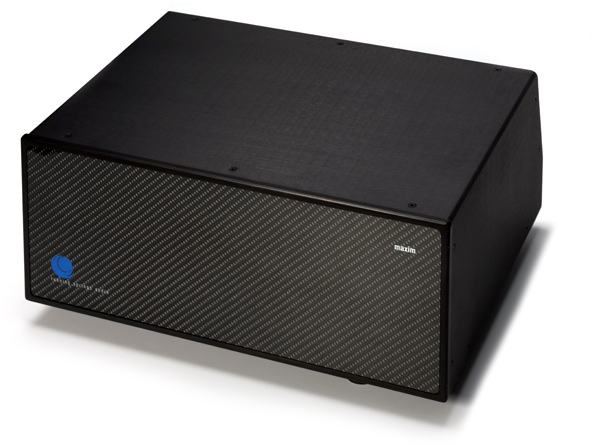 As a long time owner of Running Springs power conditioning products, I was very anxious to hear the effect of their newest power conditioner, the Maxim on my system. Unlike a number of other power product manufacturers at the recent Rocky Mountain Audio Fest that made outrageous claims for their power products (two of which have already been returned to their companies already), RSA designer Dan Babineau simply told me, “If you like your Dmitri, the Maxim uses the advancements I made going from the Haley/Jaco/Danielle series of our products to the Dmitri, but with additional filtering. It’s been optimized for high power/high current amplifiers.”
As a long time owner of Running Springs power conditioning products, I was very anxious to hear the effect of their newest power conditioner, the Maxim on my system. Unlike a number of other power product manufacturers at the recent Rocky Mountain Audio Fest that made outrageous claims for their power products (two of which have already been returned to their companies already), RSA designer Dan Babineau simply told me, “If you like your Dmitri, the Maxim uses the advancements I made going from the Haley/Jaco/Danielle series of our products to the Dmitri, but with additional filtering. It’s been optimized for high power/high current amplifiers.”
The new Maxim has an MSRP of $4,500 and the optional HZ power cord is another $1,495. The standard Mongoose power cord is $695.
In six years the RSA line conditioners have been the only ones I’ve been able to use in my system, that I could plug a power amplifier into without negative results; mainly the squashing of dynamics at modest to high volume. Every other power conditioner I’ve tried has fallen down when I’ve plugged my CJ Premier 350 or Burmester 911 mk.3 amplifier in. I’ve heard a couple do a respectable job at cleaning up the power (however, not as good as the RSA), but the minute you plug a big amplifier, the magic is gone.
In my reference system, most of my line level components (preamplifier, phono preamplifier, turntables and DAC) are plugged into the Dmitri on its own dedicated 20-amp circuit. My Naim CD555 has it’s own dedicated 20 amp line with a Running Springs Haley and the power amplifier on another 20 amp line with a Jaco.
How much further can it go?
I was particularly interested in torture testing the Maxim because I was working on a few high power amplifier reviews for our December issue. We’ve got the SimAudio Moon W-7 monoblocks at 500 watts per channel, the Burmester 911 mk. 3 at 350 per channel and the McIntosh MC1.2kw monoblocks at a staggering 1200 watts per channel as part of the lineup. And there’s a JL Audio Gotham hanging around with the ability to put out about 4000 watts in short bursts, so I couldn’t think of a better trial for the Maxim.
The Maxim took me by surprise because I was already content with the Jaco in my system, paired with the HZ power cord. Though I approached this with some skepticism, the result of swapping the Jaco for the Maxim was not subtle.
Immediately, I noticed a lower noise floor overall. This is instantly perceived as an increase in volume, because what your ear interprets as an increase in volume is actually the difference between loud and quiet. So if you want your system to sound louder, you can get more juice by making it quieter. Everything appears louder for the same given SPL.
Even more exiting was the increase in soundstage width and depth. With the Jaco in place, it seemed like the soundstage went about a foot beyond the speaker boundaries of the Gamut S-7’s that I used as the benchmark for all of my amplifier tests, but with the Maxim in place on the same music, the soundstage went about four feet beyond the speaker boundaries.
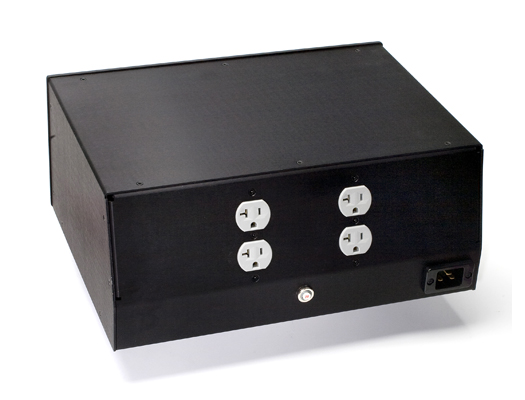
Keep in mind, with both power conditioners, the tonality of acoustic instruments stayed consistent and I could still wind out a big power amplifier without the leading or trailing transients getting shaved off, but in every case, the sound was bigger and slightly louder with the Maxim in the system. This effect also remained consistent, whether I was using the big Macs or my CJ LP70S, which is only 70 watts per channel.
The serious torture test was playing music at moderate to high levels with the big power amplifiers I had at my disposal. When those big blue meters on the MC1.2kw’s start swinging up past 600 watts per channel, you need current and that’s what the Maxim delivers. If you take a glance on just about any HiFi forum, you’ll see any number of posts where people throw their arms up and mention that their system always sounds more dynamic and lifelike when they just plug back in the wall. With the Maxim it’s just the opposite. Whether you are blasting Shostakovich or Snow Patrol, your system will exhibit a level of dynamics you didn’t think possible.
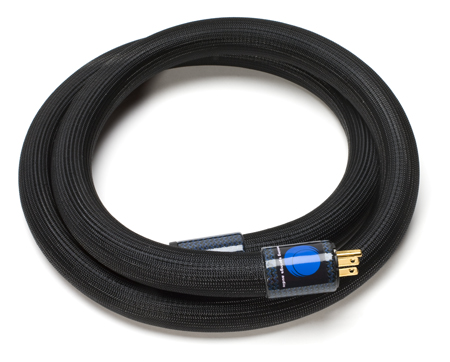
Is it real or is it Memorex?
Of course the human ear is fairly adaptive and it’s very easy to get used to the sound of one component over another after a while. After about a month of continuous listening with the Maxim, I plugged my Jaco back in the system to see if I really “needed” a Maxim. Everything shrunk down by a substantial amount and the system got slightly quieter, even at low volumes.
Keep in mind a power conditioner should not affect the tonality of your system at all. You shouldn’t get deeper bass or a more extended high end. Properly implemented, a good power line conditioner and associated power cords should merely deliver 100% of what your components are capable of delivering. No matter where you live, your power is moderately lousy to really lousy, because there are a lot of distortion components present in the line when power is generated. In short, things should get quieter and bigger. That is precisely what the Maxim does.
So, do I need one? You bet I do! If you have a modest system, it doesn’t make sense to buy a $6,000 power conditioner and power cord. Grab a Haley and enjoy the benefits. But if you’ve got a state of the art system and you’re already at 11, thinking there’s no where else to go, rest assured; there’s one more click on the dial with a Maxim.
The Running Springs Maxim Power Conditioner
MSRP: $4,500 (alone) HZ power cord, $1,495, Standard Mongoose power cord, $695
www.runningspringsaudio.com
Peripherals
Analog Source Spiral Groove SG-2 w/Triplanar arm and Lyra Skala cartridge
Digital Source Naim CD555
Preamplifier Conrad Johnson ACT2/series 2, Burmester 011
Power Amplifier Burmester 911 mk.3, CJ Premier 350, CJ LP70S, McIntosh MC1.2KW monoblocks, SimAudio Moon W-7 monoblocks
Speakers YG Acoustics Anat II Studio, Verity Audio Sarastro II, GamuT S-7
Interconnects Shunyata Aurora
Speaker Cables Shunyata Stratos SP
Power Running Springs Dmitri and Haley, RSA Mongoose power cords, Shunyata Python CX power cords
Red Wine Audio’s Black Lightening Redefines Quiet
I just got my hands on one of Vinnie Rossi’s new Black Lightning power supplies and it’s fantastic.
Based on the same SLA battery technology he uses in all of his other products, this is now available as an external power supply that can be used with just about anything that relies on an external, switching mode power supply. Wall warts are very dirty and give off a lot of RFI as well as dumping noise back into the power line for your gear to pick up and ultimately cloud the presentation of your system.
We’ve got a full review in the works, but the short version is buy one of these. I’m using the review sample with my Nagra VPS phono stage and the result is stunning. The RWA supply redefines “black backgrounds.”
I’ll keep you posted, but this one’s a winner.
MartinLogan Purity: HiFi with ease!
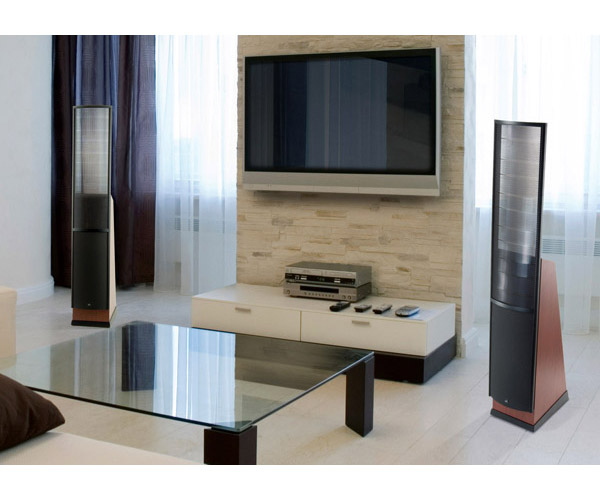 In the last few years, MartinLogan has received a lot of praise for their hybrid electrostatic designs, mating their legendary electrostatic panel to a dynamic woofer. In the case of the Purity, it’s a pair of 6.5-inch woofers in a very compact package that will only take a 10 x 15 inch patch of your living area.
In the last few years, MartinLogan has received a lot of praise for their hybrid electrostatic designs, mating their legendary electrostatic panel to a dynamic woofer. In the case of the Purity, it’s a pair of 6.5-inch woofers in a very compact package that will only take a 10 x 15 inch patch of your living area.
What makes the Purity special though, is the fact that these are powered speakers, so you only need a source component and a pair of fairly long interconnects to build a complete system! These speakers feature a 200-watt, high resolution, switching amplifier built in, so if you want high quality HiFi, but don’t want a rack full of gear to go along with it, the Purity is for you. You can even run them with an iPod or Squeezebox and have the ultimate minimalist system. The Purity can be customized for different color options, at a base price of $3,295.
Small sources
That’s exactly where I started my journey with the Purity. In my small (11 x 17 foot) living room with my iPod full of Apple Lossless files and a pair of 8 foot Radio Shack interconnects. Worth noting when you set the Purity up for the first time, there is a hard plastic base on the bottom of the speakers that will tilt the speakers’ electrostatic panel back somewhat or keep it straight up.
Pay careful attention to this adjustment, because tilting them back gives the speaker a better overall tonal balance if you are going to be listening to the speakers primarily walking around the room or mostly standing. If you are going to be more of a traditional audiophile, listening in your chair, stand them straight up. Note, that with either of these positions, you will lose some of the high frequency and focus when you are not in the optimum listening position.
Tech info
If you’ve got a high quality source, you will be floored at how good the Purity sounds and how much music comes out of these relatively small speakers. I’m guessing you will be in one of two camps: A legacy MartinLogan owner that needs another pair for a different room in your home or office or someone new to the MartinLogan way of doing things.
If you are new to the electrostatic speaker experience, you’ll be surprised at how open and airy these speakers sound compared to a lot of box speakers, and that’s MartinLogan’s trademark. The diaphragm inside the panel assembly weighs close to nothing, so it can accelerate instantly. Thanks to the crossover frequency being so low (450hz) this panel handles most of the critical musical information and the two small woofers give you the same amount of bass you would get with a larger woofer, but in a smaller space. Those two small woofers also move faster, to keep up with the panel, adding to the overall transparency of the sound.
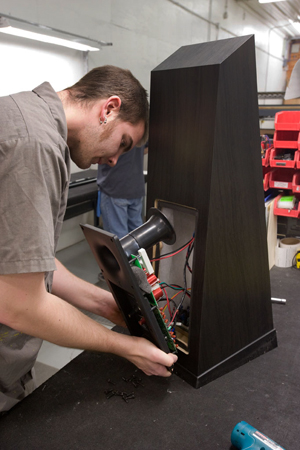
If you’re already a MartinLogan owner, you know all this stuff and you probably want to know how the Purity compares to the larger speakers you already own. The actual panel in the Purity uses the same materials and construction as the rest of the MartinLogan line (all the way up to the flagship CLX, which is one of my reference speakers), featuring their 2nd generation electrostat panel technology.
Wow!
Even using my iPod as a source, I was very impressed with the sound of the Purity. Think of the Purity as a bite-sized serving of what the CLX has to offer. When sitting in the sweet spot, it’s easy to be fooled at first listen that you aren’t hearing something much more expensive than the Purity and that’s it’s best attribute.
Granted, a switching amplifier has some limitations and because of the two 6.5 inch woofers, these speakers will reproduce solid bass down to about 40hz, where MartinLogans’ larger speakers will go all the way down to the mid 20’s, the overall balance is excellent.
As a MartinLogan owner, I was excited at just how much sound I could coax out of these speakers. After quite a bit of iPod listening, my next task was to investigate the limits of performance these speakers were capable of, so my next task was to drag out some better interconnects, power cords and source components to find out if this was a serious HiFi speaker after all.
Upping the ante
Again, the Purity passed with flying colors. Now, my “budget” system consisted of the Audio Research SP-17 preamplifier that we had in for review along with the Marantz K-A1 Pearl CD/SACD player. Both of these components cost almost as much as the Purity, and I did upgrade from Radio Shack interconnects to two pair of ED422 interconnects from Empirical Design, valued at about $500 each. I swapped the stock power cords from the Purities for a pair of Shunyata Venom cables ($125 each) and plugged the whole system into a Running Springs Haley power conditioner.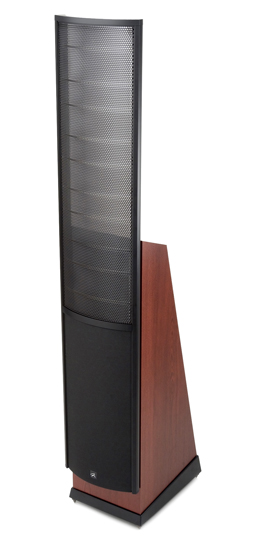
Bottom line, the Purity is up to the task of being the cornerstone of a real “audiophile” system too, so even if you start out just using the Purity with an iPod, you can rest assured that if the upgrade bug bites, you can grow with these speakers.
The Sound
The sound is pure MartinLogan. Open, airy highs, walk through midrange and tight punchy bass. I kept going back and forth between my dedicated listening room where the CLX’s make up a six-figure system and the Purity in my living room with the ARC/Marantz combination, playing the same CD’s on each.
The Purity did a fantastic job with everything I played. My favorite rock records had plenty of body and of course, vocal records really let these speakers shine. At times, you could definitely hear the limitations of the switching amplifiers present in the Purity, but that was only when comparing the system to my reference system. I think MartinLogan has done a great job with integrating the amp and speakers.
When playing musical selections that did not possess huge dynamic swings or subterranean bass notes, it was easy to be fooled when going between rooms. I was surprised at how good the speakers’ bass response was, considering the printed spec lists the LF response at 41hz. Yep, the driving bass line in “In-A-Gadda-Da-Vida” came through loud and clear. Speaking of loud, these babies did a great job with my favorite Mastodon, Tool and Metallica cuts, so they should be able to play anything else that interests you after this torture test.
While the Purity does not have the full scale of dynamic range that the more expensive Vantage or Spire possess, it does one thing better than most of the speakers in the MartinLogan line; top to bottom coherency. Those small woofers are fast and articulate. So much so, that you might be fooled into thinking this is a full range electrostat!
The only real limitation to the Purity is that the sweet spot for critical listening is small. If you have them angled back, the sound is very good all over the room, but the best sound will only be in one spot. Same thing if you have them optimized for your chair; that will be the only place you get all of the magic. Keep in mind you would have the same limitations with a small pair of mini monitors in this kind of space too, so I don’t see this as a limitation.
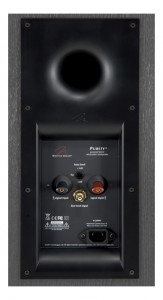
I also made it a point to run some fairly long interconnects to these speakers, as they only have RCA line-levelinputs. While I didn’t have any trouble with 20 foot interconnects, it might be a good idea for the next version of these to have balanced XLR inputs as well. Those with a budget source only possessing speaker level outputs can connect via the speaker level inputs as well.
In the end, convenience
Thanks to the internal power of the MartinLogan Purity, they make a great place to put a high quality sound system, where you might not have in the past. In five minutes you can have them set up and playing music and that’s what it’s all about. Though some of you might get grumpy that a powered speaker doesn’t give you the flexibility to choose amplifiers, speakers, etc., you’re missing the point; the Purity is the perfect speaker for someone who doesn’t want to bother with all of that! Plug em in and enjoy.
Because the Purity offers this level of performance, style and simplicity in one package at such a great price, we are awarding it one of our Publishers’ Choice awards for 2009.
The MartinLogan Purity
MSRP: $3,295
www.martinlogan.com
Peripherals
Sources: iPod Touch, Audio Research SP-17 preamplifier, Marantz K1 Pearl SACD player
Cable: Empirical Design ED 422 interconnects, Shunyata Venom Power Cables
Accessories: Running Springs Haley power conditioner
Rega Elicit – A top shelf integrated
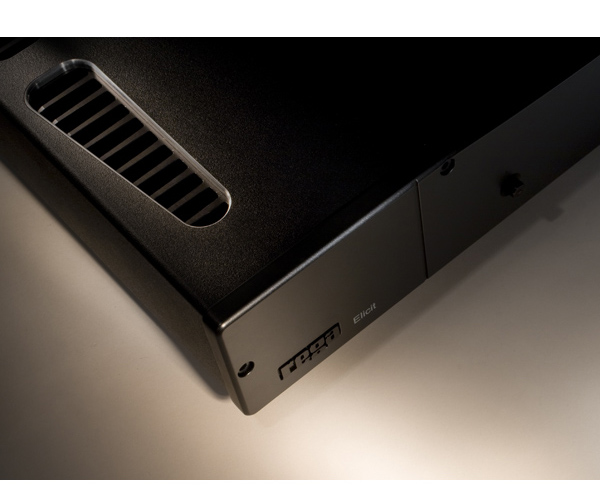 Ed. Note: This review was published in late 2008, but we somehow failed to upload it this spring when the site was overhauled. Our apologies!
Ed. Note: This review was published in late 2008, but we somehow failed to upload it this spring when the site was overhauled. Our apologies!
Rega has had a string of great products lately, including the improved P3-24 turntable and the stellar Ios phono preamplifier. While I might be accused of being biased toward Roy Gandy and company, it’s pretty hard not to like them when everything they’ve sent our way has been such a home run. Actually, I’m getting more and more biased towards having a great integrated amplifier in your system.
Integrated amplifiers in general have been making a comeback for a while and we’ve had quite a few of them in our paws this year that have been spectacular. The Sim Audio Moon i-7 at $7,000 is one of my favorites and features a beefy 150-watt per channel power amplifier section. The Naim SuperNait at $5,000 is less powerful but has a versatile DAC built in along with a fantastic headphone amplifier stage.
Perhaps you don’t require a built in DAC or a headphone amplifier and you would like to spin some LP’s without having to purchase an outboard phono stage? Enter the Rega Elicit. For $3,000 without a phono stage or $3,200 with your choice of MM or MC card installed, the Elicit could be the amplifier for you. My review sample came with an MM board, as Rega did not yet have the MC boards in stock, so we will do a follow up on the MC board as soon as we receive one.
The Elicit has more than enough inputs to be the center of your HiFi system. If you order yours with the phono board installed, there are five more high level inputs; four on the input selector as well as a tape monitor input. There are three outputs as well; a variable level output marked “preamp output” that you can use with a powered subwoofer or perhaps an additional power amplifier in a biamped setup, a fixed level output marked “record output” for a tape recorder, CD recorder, etc., and an additional fixed output marked “record output link” which is functionally equivalent to the record output. Rega says that the phono preamp is a plug in card and mentions “future options.”
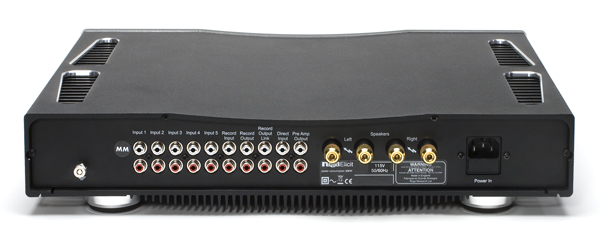
The Elicit is rated at 82 watts per channel and while we don’t measure our amplifiers output on a bench, I can say that it played just as loud with the same speakers as the Naim SuperNait (rated at 80 watts per channel), so as long as your speakers have a sensitivity of at least 86db the Elicit will have enough power for your application. I do find the subwoofer output critical for an amplifier at this level, I’ve auditioned too many pricey integrateds that ignore this feature.
This amplifier is continuing in the path that Rega has started down with the Ios phono stage as part of their premium line of components. “This is the best integrated we are capable of making” Roy Gandy told me in a recent phone conversation. “The circuit has actually been around for a while and we’ve been refining it.” If you aren’t familiar with Rega as a company, they do not rush to market with anything, always waiting until a product is built exactly the way they want it. Their website says at the bottom of the page “they are the last major HiFi manufacturer to produce a CD player.”
Peeking inside the Elicit shows the attention to detail, with premium parts everywhere and I’d like to emphasize that there are no Class-D modules or op amps anywhere; the Elicit’s circuitry is all discrete.
Music in five minutes
Even with a turntable, CD player and subwoofer, I was rocking out in no time with the Elicit. The instruction manual is straightforward, as is the remote. As you are lifting the Elicit out of the box, you will notice how beefy it is – there’s a major power supply lurking under the casework. With a similar form factor to the rest of the Rega components, the Elicit will look right at home with a P9 and PSU power supply, an Ios phono stage, or a Rega CD player. The big difference is the openings cut in the left and right sides, revealing some massive heat sinks for the output stages.
The volume control is somewhat recessed in the front panel and is microprocessor controlled, changing volume in +/- 1db steps. Rega claims better than .2db channel balance, which I had no reason to doubt. I liked the row of LED’s that light up around the volume control as you increase the level, as an alternative to a large LED panel with numbers. And yes, those of you that get grumpy about glowing LED’s can dim them from the remote.
Top quality sound
You’ll forget all the specs the minute you fire up the Elicit; this is something special indeed. While I liked what I heard immediately, after a couple of days of continuous play the Elicit opened up even further.
Because I see the Elicit as the core of a very high performance system, I made it a point to use it with quite a few different speakers, including the MartinLogan Spires in for review as well as the 53 thousand dollar Loiminchay Chagalls. Even with the mega Loiminchay’s, which are known for their exceptional resolution of fine detail, the Elicit held it’s own.
The good news is that the Elicit has enough current drive to power the Logans just fine and every other speaker I was able to throw at it. So unless you need concert hall levels or just have tremendously inefficient speakers, the Elicit should be able to drive most speakers with ease. I ended up settling in on the system mentioned in the sidebar, with a pair of Harbeth Compact 7ES-3’s, a Rega Saturn CD player and a Rega P3 turntable with Clearaudio cartridge.
I’m fortunate enough to have a very high performance system to listen to every day and while this system I’ve assembled does not eclipse my six figure reference setup, it does nail the fundamentals so well, that it’s easy to forget that you aren’t listening to a much more expensive system. Listening to music that isn’t terribly demanding on the frequency extremes, like the new James Taylor album, Covers, or perhaps some chamber music will easily fool you into thinking you are listening to something a lot more expensive.
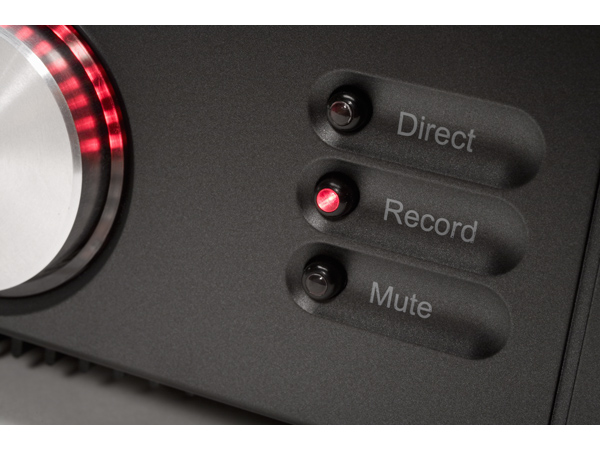
What fools you into thinking that you are listening to much more expensive gear is the tonality that this amplifier provides. While you won’t confuse the Elicit for a tube amplifier, it does have a drop of warmth to the presentation, sounding closer to the Luxman 590 (All class-A) than say the Moon i-7 or the SuperNait. Listening to my favorite classical discs was very pleasant indeed, with the Elicit having an unmistakable ”rightness” about it.
I briefly added the Luxman D-7 combination player that we have in for review, so that I could listen to the new Analogue Productions SACD release of Sonny Rollins Saxophone Colossus and it was awesome, showing off the dynamic capabilities of this amplifier. When Sonny blasts away, the Elicit did a fantastic job at capturing the transient attack. I had equally good luck with some of my favorite Mahler and Shostakovich discs. At moderate to loud levels, I always felt like there was enough headroom to enjoy the music without strain.
The Elicit’s performance under torture is also worth mentioning. I spent a few hours working outside the studio and had a good playlist full of Led Zeppelin, Van Halen and Snow Patrol playing, running the Elicit at full volume for about four hours straight. The heatsinks got a little warm, but not hot to the touch, indicating robust build quality.
At the risk of sounding vague, the Elicit is very musical. While some solid-state amplification, especially at this price point can sound somewhat harsh and fatiguing, this was never the case with the Rega. Towards the end of the review period, I moved it to my desktop system with a pair of Stirling Broadcast LS3/5a’s and MartinLogan Grotto i subwoofer. This system has incredible midrange detail and a very smooth high end along with an uncanny amount of resolution listening nearfield. Anything that is the least bit fatiguing will become torture during 10-hour Photoshop editing sessions.
Having spent the last two weeks of producing the August issue, listening to this combination nonstop, it was always enjoyable, even after 12-hour shifts, playing a very wide variety of music. I’m sure the parts quality and all discrete circuitry had a lot to do with this.
The hidden jewel
I was not prepared for the surprise that I had when I plugged my P3-24 into the Elicit. I have reviewed a number of integrated amplifiers and preamplifiers that charge $500-700 dollars for a plug in phono board that aren’t nearly as well executed as this one is. While I used Rega’s P3-24 with the Clearaudio Maestro Wood at first, I was so impressed with what I heard, I even upped the game, going to my P9 and Grado Statement combination. While this was pushing things beyond the resolution of the onboard phono stage, it still sounded great.
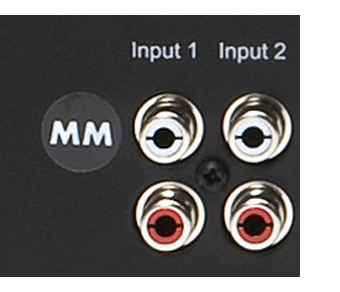
The internal phono board more than held it’s own when comparing it to a few of the $700 external phono stages I’ve had the opportunity to sample, so for many vinyl lovers, this will be a great place to start. Being solid state, it is extremely quiet with good dynamics and an amazingly open top end for an under $200 upgrade.
Granted the internal phono stage will pale in comparison to Regas Ios (which costs as much as the Elicit), but it’s a great place to start. That being said, using the P9 with the Ios and the Rega Apheta MC cartridge was very impressive indeed. Not a bad way to go for a compact, all analog system!
A great alternative to separates
With integrateds gaining momentum all the time, if you haven’t investigated them in a few years, you will be taken back by just how much performance is now available. The Elicit is the perfect amplifier for someone who wants a high performance music system, regardless of configuration. The fact that you need fewer cords and cables is a big bonus.
Remember, what you get for $3,200 is a preamplifier, a darn good phono preamplifier and a power amplifier all on one chassis. Even buying modest interconnects in an all separates system would be another few hundred dollars and you would require a lot more rack space to get the job done.
It’s also very important to point out that while some of you in the audience might not quite grasp the significance of this $3000 British integrated, Rega has never made an integrated at this price point. They’ve built an amazing reputation on their Brio at $695 and the Mira at $1195, so this is big bucks for Rega. The Elicit offers so much at this price point because Rega builds their products in quantity and everything shares similar casework and packing materials. Unlike some boutique products that penalize the owner for building in small numbers, Rega reaps the rewards for running a tight ship and passes those savings on to their customers.
I defy anyone to put together more performance with a separate power amplifier, preamplifier and phono preamplifier at this price point. I’m happy to say that we are purchasing the review sample to become part of the permanent collection here at TONEAudio.
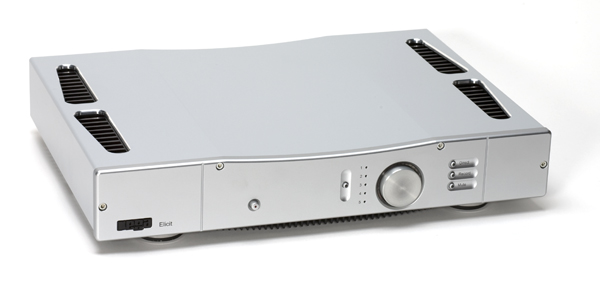
The Rega Elicit
MSRP: $2,995
www.soundorg.com
Peripherals:
Analog sources Rega P3-24, Rega P9, Rega IOS phono stage
Digital sources Rega Saturn, Luxman D-7i
Speakers Harbeth Compact 7ES -3, MartinLogan Spire, Stirling Broadcast LS3/5a
Cable Furutech Reference III (speaker and interconnect)
Accessories Running Springs Haley with Mongoose power cords, Finite Elemente Pagode Signature Rack
Win Analog – BIG tube power
If you love the sound of a great SET but want more than a few watts, so you can really rock, Win Analog is the place to get it.
I saw their new 833 based monoblocks at the Rocky Mountain Audio Fest and almost didn’t go in the room fearing that they were $300 thousand a pair, like WAVAC.
The good news is that they are $75 thousand a pair, and while that’s not exactly grocery money, it puts these 130 watt per channel SET monoblocks in the reach of the most demanding listeners.
I’ve spent the day at Win Analog listening today, and came away highly impressed. These beautiful amplfiers deliver the goods!
For more information, go to their website:
TONEAudio Magazine 24
Features
Old School: The Audio Research SP-9
By Kurt Doslu
The Journeyman Audiophile: Moving Up The Cartridge Food Chain
By Jeff Dorgay
Budget Gear: How Much Analog Magic Can You Get For Under $100?
By Jerold O’Brien
Here Today, Gone Tomorrow: MoMA’s New York Punk Exhibit
By Bob Gendron
The Grateful Dead: The Sounds and The Songs
By Ben Fong-Torres
Home is Where The Record Player Is A Turntable for Everyone
By Jeff Dorgay
Tone Style
The Leica M9
The Ducati Hypermotard
Furutech’s Monza LP Stabilizer
Furutech’s Silver Arrows Tonearm Cable
Furutech’s LaSource Cartridge wires
The Clearaudio Strobe
Clearaudio’s Weight Watcher
Music
Live Music: The TONEStaff Covers Alice In Chains, The Derek Trucks Band, Wilco, John Hiatt/Lyle Lovett and the return of Mott the Hoople to the stage.
Current Releases:
Fresh Releases in the Pop/Rock World
By the TONE Staff
Audiophile Pressings Presented by Music Direct
Thelonius Monk, Stanley Turrentine, Frank Sinatra, Michael Brecker and more.
Club Mix:
Selections From the Six Degrees Catalog
By Scott Tetzlaff
Previews
Burmester’s 911 mk.3
KEF XQ20’s
YG Acoustics Anat II’s
Reviews
Headphone Planet
By Bailey S. Bernard
Rega P5
Plug and Play Analog
By Rich Kent
Air Tight PC-1 Supreme Cartridge
By Jacob Heilbrunn
Manley Steelhead RC
By Jeff Dorgay
Conrad-Johnson’s TEA2
By Randy Wells
Two Top Cartridges for Mono Lovers
By Lawrence Devoe
Audio Research SP-17
By Jeff Dorgay
Shunyata’s Aurora Interconnect and Statos SP Speaker Cable
By Jeff Dorgay
The Shelter 901 II Cartridge
By Jeff Dorgay
Perreaux Eloquence 150i Integrated Amp
By Steve Guttenberg
The Clearaudio DaVinci Cartridge
By Jeff Dorgay
SimAudio’s Moon LP 5.3 with PSX 5.3 Power Supply
By Jeff Dorgay
Soundsmiths “The Voice” cartridge
By Jeff Dorgay
SLUMMIN’
The Marantz 150 Tuner
The Ultimate Record Cabinets, On Sale!
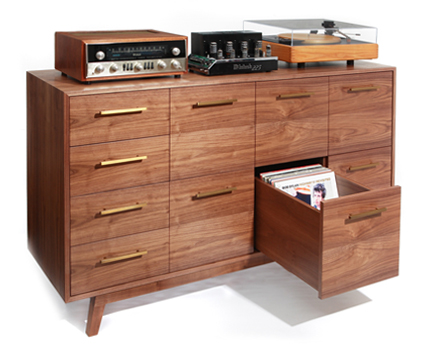 Last year we featured what I consider to be the ultimate record cabinets, from Atocha Design. These are custom, made to order cabinets that you can have configured to suit your record (and CD) collection. If you’ve been wanting to treat yourself to something special this holiday season, now’s the time to do it…
Last year we featured what I consider to be the ultimate record cabinets, from Atocha Design. These are custom, made to order cabinets that you can have configured to suit your record (and CD) collection. If you’ve been wanting to treat yourself to something special this holiday season, now’s the time to do it…
Third day added for Seattle event…
 Connon Price of TUNE HiFi in Seattle has just informed us that Pat will be stopping by a day early for the clinic, so feel free to drop in on Thursday to check out the DAC, NaimNet gear and get started on your upgrades.
Connon Price of TUNE HiFi in Seattle has just informed us that Pat will be stopping by a day early for the clinic, so feel free to drop in on Thursday to check out the DAC, NaimNet gear and get started on your upgrades.
First stop: Portland!
I stopped by at Stereotypes to see Pat working away on a customer’s power supply…
I expected him to be in the back room sequestered away, but they had him front and center, with a gigantic work bench set up in the middle of the showroom! Pat had a soldering station set up, a distortion analyzer ready to go and a number of tool boxes as well as piles of capacitors everywhere.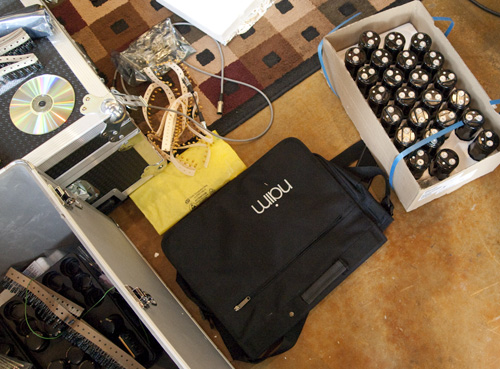
The store has had a great turnout, with a number of people coming by to see the new Naim DAC, and all 22 service spots had been taken. By the time I had reached the store at noon, Pat said he “only had about five more units to go…” Not only is this level of customer support excellent, it also redefines what you might consider “being green”. Anytime you can bring something back to spec without throwing it away, that’s always a good thing for the environment as well as the customer!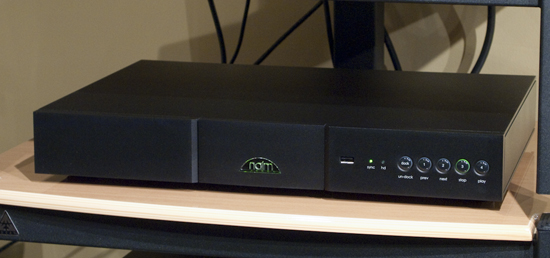
15 Jerold O’Brien
Our publisher can’t remember if he first met Jerold at a Badger game at the University of Wisconsin or standing in line waiting to see the Rocky Horror Picture Show on Milwaukee’s East Side.The staff hermit, Jerold now also resides in the Pacific Northwest where he listens to a lot of 60’s and 70’s rock music, restores old BMWs and vintage tube amplifiers. He is the only member of the staff that does not have a Spotify subscription.
22 Tom Caselli
A Native New Yorker, Tom is our musical encyclopedia and a discerning audiophile to boot. A devout Jimi Hendrix collector who has “everything but Jimi’s casket”, Tom brings a wealth of knowledge to the staff. If it has anything to do with popular music from the 60’s or 70’s, he’s got it and usually has at least 20 different pressings to compare. (And he’s got a pretty awesome collection of GI Joe’s too!)
Tom lives in the suburbs of Atlanta with his family and his collections.
02 Jaan Uhelszki
Jaan Uhelszki was one of the founding editors at Detroit’s legendary Creem magazine. Since that time, her work has appeared in leading publications including USA Today, MOJO, Uncut, Rolling Stone, Spin, NME, Guitar World, and The Village Voice.
Currently the editor at large at Relix, she is the only journalist to have ever performed in full makeup with Kiss. These days she only feels compelled to put on Serge Lutens kohl black eyeliner and Dior mascara when she goes out to grill rock stars over an open pit.
Music Hall’s new PH25.2 Headphone Amp
The ph25.2 is tube hybrid headphone amp/pre-amp. It has 2 x buffered headphone outputs, 2 x inputs, tube pre-amp section, solid-state amp, and pre-output. Marrying a gorgeous sounding tube pre-amp with solid-state  amplification has been a technique for achieving unequaled sound quality in hi-end component audio since the advent of the transistor. While kicking around ideas for our new headphone amp we thought, why not try this same technique in a single component? We built one up and were blown away by the increased detail, clarity, and presence the design offered. The tube hybrid headphone amp was born. Hand assembled using the highest quality parts available the music hall ph25.2 will have you singing along with your favorite artists. A full featured headphone amp in a beautiful and solid chassis.
amplification has been a technique for achieving unequaled sound quality in hi-end component audio since the advent of the transistor. While kicking around ideas for our new headphone amp we thought, why not try this same technique in a single component? We built one up and were blown away by the increased detail, clarity, and presence the design offered. The tube hybrid headphone amp was born. Hand assembled using the highest quality parts available the music hall ph25.2 will have you singing along with your favorite artists. A full featured headphone amp in a beautiful and solid chassis.
Rega’s Trade-in Program
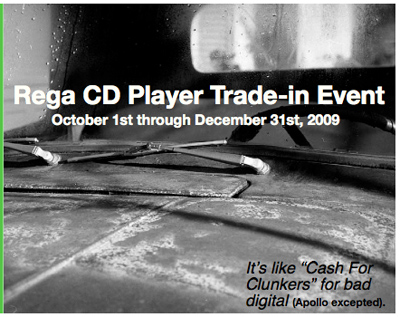 Doing their bit to stimulate the economy and promote better digital sound, the US distributor for REGA, The Sound Organisation is promoting their version of a “Cash for Clunkers” program. Bring in your old CD or DVD player and get a 15% discount on a new Apollo player, or 25% off on a new Saturn player. This is a pretty sweet deal and it’s running until the end of the year.
Doing their bit to stimulate the economy and promote better digital sound, the US distributor for REGA, The Sound Organisation is promoting their version of a “Cash for Clunkers” program. Bring in your old CD or DVD player and get a 15% discount on a new Apollo player, or 25% off on a new Saturn player. This is a pretty sweet deal and it’s running until the end of the year.
Sounds like a great time to upgrade…
Rega’s Flagship CD Player The ISIS is Here!
Literally just off the FedEx truck about 15 minutes ago, Rega’s ISIS CD player has arrived. The retail price is $8,995 and this is a great deal for US customers as the player carries a 6,000 pound pricetag in Europe.
I had the opportunity to audition the ISIS when I visited Rega last summer and it was superb. Fans of Rega and their founder Roy Gandy know that they never jump into anything quickly and when they do, the results are always excellent.
The ISIS can also be used as a full function DAC, so this will add tremendously to its appeal. Stay tuned and we will keep you posted with more listening impressions.
Pathos ClassicOne mk.III
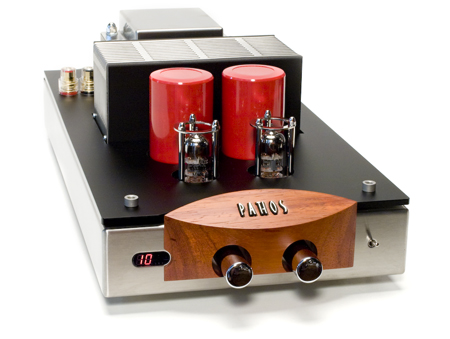 I’ve always been a fan of Pathos Acoustics fusion of Italian style with technology, while always yielding very musical results.
I’ve always been a fan of Pathos Acoustics fusion of Italian style with technology, while always yielding very musical results.
The Classic is the perfect integrated amplifier for someone wanting to integrate a compact, yet high performance music system into a design conscious environment. It is very reasonably priced at $2,995.
The ClassicOne mk. III has been part of the Pathos product lineup for some time now and is a solid seller, packing 70 watts per channel onto a very compact chassis that only measures 8” x 14” x 5” (90 x 100x90mm). Though there are five inputs on the rear panel, input one can be either balanced XLR or RCA, with the other three being RCA. There is also a fixed level RCA output to use for recording. I would love to see a variable level output for a subwoofer substituted here. I think this would be highly useful, as often times when a system has to be designed around the decor, a subwoofer/sattelite setup is called into play. Perhaps in the mk. IV?
Major Style Points
From the minute you take the ClassicOne out of the box, the attention to detail is apparent. The front panel is polished aluminum and sculpted wood, with a tiny power switch to the right and an LED display to the left, working double duty as a volume indicator and input selector. The transformer case is polished to a high gloss while the black plexiglass chassis top has a matte finish, something I felt was a nice touch, as it will not show fingerprints as readily as a gloss black surface. The very svelte remote control is made from solid wood and has four small buttons to control inputs, muting and volume.
No attention to detail has been spared on the ClassicOne. The allen head bolts on the top of the chassis are chrome plated along with the control knobs and the small tube cages guarding the pair of 6922 tubes in the preamplifier section. This is definitely a work of art that will get plenty of attention in your listening environment.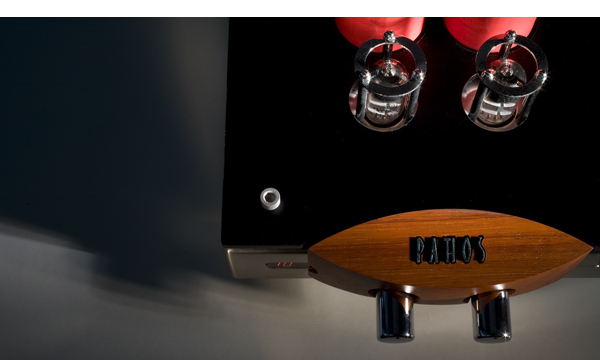
A true integrated
Unlike many amplifiers at this price point, the ClassicOne has a separate pre and power amplifier stage. Taking this approach is more costly to the manufacturer, but it does offer more linear volume control action as well as a stable input impedance. Many so called integrated amplifiers with a passive volume control tacked on the front of a power amplifier can be very source dependent, sometimes sacrificing dynamics or rolling off the high end somewhat. I had no problems using the ClassicOne with any of my reference components.
The output stage of the power amplifier is class AB solid state, with high bias current. This uses a few more watts of power, but results in a smoother sound throughout the range, with excellent bass control.
The System
Keeping with the design concept of the ClassicOne, most of my listening was done in the living room system, however to get a good feel for the performance envelope of the amplifier, I started out in the studio, using the GamuT S-7’s, Harbeth Monitor 40.1’s and MartinLogan Spires. Mating a $3,500 amplifier with considerably more expensive speakers is somewhat overkill, but it reveals the limits of the amplifier much easier.
Even as the heart of a $100,000 system, the ClassicOne did an excellent job. I also made it a point to compare it to a couple of my other favorite amplifiers in the three to ten thousand dollar range to see how it stacked up against its peers. Needless to say, I came away very impressed. Should you live with the ClassicOne for a while and decide you have to have more power, the ClassicOne can be bridged and used in mono mode, giving you a pair of very compact 150-watt amplifiers.
We managed to get a second ClassicOne for a brief period and the results were excellent. I’m not sure if I would build a system like this from the ground up, probably choosing one of Pathos larger power amplifiers instead, but the flexibility is a great idea.
Once a baseline feel for the ClassicOne’s performance was established, I moved it back to the living room system, with the highly efficient Zu Audio Presence speakers. This was a great match, because the Zu speakers high sensitivity gave the ClassicOne almost unlimited headroom.
The system was rounded out with the BelCanto CD1, which has a similar form factor to the ClassicOne, though I’m sure if you were starting from scratch, you’d probably want to go with the Pathos Digit CD player – it matches the aesthetics of the ClassicOne perfectly.
Shunyata Venom cables and their VRay power conditioner took care of the power duties with Empirical Design 422 interconnects and 213 speaker cables made up the rest of the system. All told, I had assembled an extremely satisfying system for just over $10,000.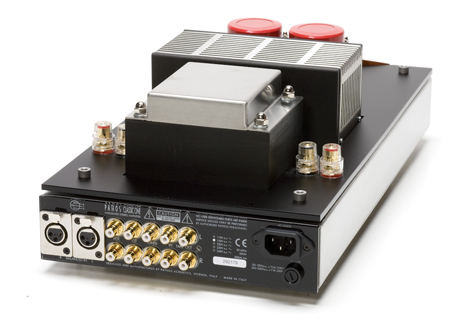
The Sound
The hybrid concept of the ClassicOne succeeds brilliantly, truly combining the benefits of both technologies. The overall tonal balance is slightly warm, yet it has the grip of a good solid-state amplifier. When listening to “The Barbarian” on Keith Emerson’s current album, the tiny Pathos amplifier took hold of the GamuT’s woofers and shook the room accordingly, with the low synth bass notes on “Ignition.”
Thanks to the ClassicOne’s rich sound, the female vocal lovers in the audience will be extremely happy. Those of you that live on a steady diet of this kind of music will love the way this amplifier gives solo vocalists a larger than life presentation. Spinning Jacqui Naylor’s Live at the Plush Room, 2001 put her center stage, about six feet in front of the equipment rack. It’s worth noting here that the ClassicOne makes an outstanding combination with the Focal Utopia Diablos that we reviewed last issue. The warmth of the Pathos with the high resolution of the Diablos convinced many visitors to my home that they were listening to a much more expensive system.
Those two tubes give this amplifier something special, offering a slightly lush, airy presentation that I think will bring out the best in source components that are similarly priced. It’s also worth noting that the ClassicOne offers one balanced input, so this will give you a lot more flexibility when choosing source components. Many of today’s newer DAC’s have balanced outputs, so this is handy, if you want to put the Pathos amp front and center, yet have your DAC and perhaps a music server elsewhere in your listening room.
The ClassicOne’s slightly forgiving nature was also a huge blessing when streaming audio from the Internet, or using the iPod as a source. The 320kb/sec feed from the Zune Pass on our living room’s HP Touch Smart music server sounded the best I’ve ever heard from a low-resolution source.
When we stepped up the game a bit and played some high res files from the Naim Label, and the B&W Music club through the Wadia 521 DAC, the ClassicOne had the necessary resolution to showcase the format.
On all but the most inefficient speakers, I had to press the ClassicOne way beyond reasonable levels to drive it to clipping (and again, you can add the second amp if you have to play that loud), even with the Harbeth 40.1’s which have a low sensitivity of 86db.
Conclusion
Overall the Pathos ClassicOne mk.III is one of those rare components that achieves a perfect balance of performance, style and value. Thanks to the small tube compliment, you will not have to worry about sourcing tubes, either. The 6922 and it’s variants are very plentiful at reasonable cost, and I don’t imagine the ClassicOne going through tubes in a hurry, so probably a new pair every five years or so should keep you running along just fine.
Whether you are a mega audiophile putting together a second system, or a music lover that doesn’t want to sacrifice aesthetics for performance, this amplifier will keep both sides of your brain very happy.
UPDATE: 10/2019
Kevin Deal from Upscale Audio/Upscale Distribution has taken over as the new North American distributor for Pathos products, and we are excited so see a true qualityphile and tube guy distributing this fine product. Here’s Kevin’s quick take on having the line:
“I have always loved Pathos. In Europe, Pathos enjoys an incredible reputation for both sound and build quality, and they are very popular. Their previous U.S. importers were not deeply technical. They sold it as being beautiful, which it is, but the real beauty is on inside. Everything is made in-house in Vicenza Italy. Even the remotes are machined at the factory. They make the best hybrids on the market. They have real chops, and we are super excited.”
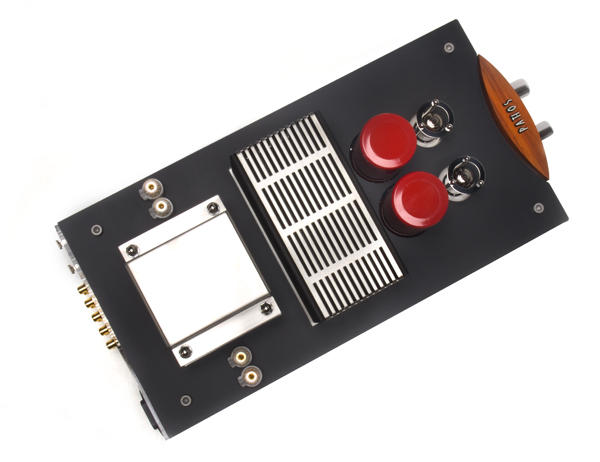
The Pathos ClassicOne Mk. III
MSRP: $3,195
North American Distributor
Upscale Audio/Upscale Distribution
2058 Wright Avenue
La Verne, California
909-931-9686
Peripherals
Digital Sources BelCanto CD3, Wadia 521 DAC, Luxman DU 7i combination player
Speakers Harbeth Monitor 40.1, Gamut S-7, Focal Utopia Diablo, Zu Audio Essence
Cable ED Design 213 and 422 (speaker and interconnect)
Power Shunyata VRay power conditioner, Shunyata Venom power cords
Vista Audio i34 Integrated Amplifier
In the world of audio, simplicity not only exists, but also is ravenously celebrated. Both Conrad-Johnson and McIntosh have produced anniversary editions of a few of their most beloved equipment. The single driver speaker community is alive and well. Most importantly, the days of mass buttons and switches have gone the way of the dinosaur, sans home theater receivers. Vacuum tube equipment thankfully has always followed a more simplified life. Though the process of developing a fine piece of glowing glass is a long and laborious process, the finished product is quite simple, and usually elegant.
Vista-Audio first caught my eye a few years back when I got to spend a few weeks with their i84 integrated tube amplifier. It was a very musical amplifier, that had a tonal purity and did an excellent job with fairly inefficient speakers, so I was anxious to sample their latest creation, the i34, which uses a pair of EL34 tubes per channel to produce 35 watts per channel. This definitely opened up the possibilities to mate the Vista sound with a wider range of speakers.
The i34 is designed and built in Serbia and is very reasonably priced at $980. It uses a pair of ECC832’s, which designer Boris Sasic feels offers the best qualities of the 12AX7 and 12AU7 in one tube. The latest version of JJ’s EL34 the EL34L’s are used for the output tubes and are supplied in a matched quad for this amplifier.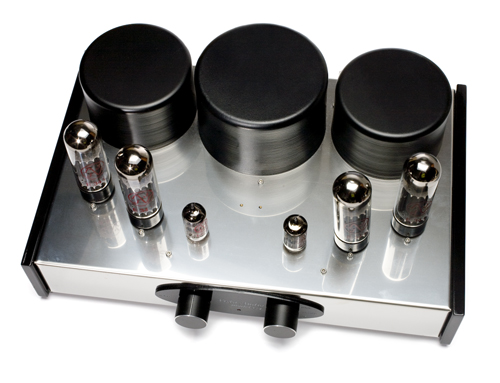
Sleek and simple
The i34 features a basic layout, reminiscent of the Dynaco Stereo 70 or early McIntosh power amplifiers with an open steel chassis, exposing the tubes and transformers. Definitely an old school approach. The transformers are sourced directly from Traformatic, who’s factory is nearby. Sasic says that this helps to keep the build cost more reasonable, because the majority of the amplifiers bulk doesn’t have to be shipped very far. The i34 weighs 24 pounds, but feels heavier than it is, definitely having a short and stout footprint.
The front panel has a simple volume control and input selector. Around back ar three sets of high level inputs marked CD, TUNER and AUX. There is also a ground for Vistas’ new phono preamplifier that I am in the process of reviewing. There are taps for 4 and 8 ohm speakers, rounded off with a standard IEC receptacle for power and the power switch, which keeps the front panel clean.
Setup and burn in
Thanks to the matched quad of tubes, the i34 leaves the factory with it’s bias already set. Sasic claims that the tubes do not need to be rebiased until a new set is fitted. Per Sasic’s direction, I gave the i34 a full week of burn in before settling down to serious listening.
Not wanting to get too much of a tubey good thing, I kept my modified Jolida CD player with a tube output stage on the sideline and used the SimAudio i.5 and the Rotel RCD-1520 CD players as sources for the bulk of the review. My usual reference speakers, the Eficion F200 speakers were used, sans MartinLogan subwoofer, as the i34 does not have a variable output to use with a sub.
The Sound
The i34 had a very open tonal quality and did not bloat breathy female vocals as some tube amplifiers can do. When listening to Nora Jones, Come Away With Me, the airy sultriness that attracts most listeners to her voice wasn’t overdone in the least. This was very similar to my memory of the i84; midrange magic, but not too much.
Thanks to the more delicate nature of the EL 34 tube, this amplifier is probably more suited to acoustic and vocal music. Unless you have incredibly efficient speakers, you won’t be able to enjoy Megadeth or Audioslave at the proper levels, though I was intrigued with the Who’s Quadrophenia when listening to Keith Moon’s drumming. While this amplifier does not hit you on the head with thunderous bass performance, the quality of the bass is excellent and the amplifier has great pace overall.
Comparing the i34 to my other tube amplifier, the Onix SP3, the Onix amplifier had more overall slam, but the i34 had more detail and delicacy. The i34 is a very resolving amplifier for its price point indeed.
Trying a few different speakers, I had excellent luck with the Swan 2.1SE monitors, which have a slight bass bump, making for an excellent match with the bass performance of the i34. The Era Design 5’s are less efficient and were not terribly enticing overall. The i34 is no different than any other 35 watt tube amplifier in this respect; careful speaker matching is necessary to get the most out of the power on tap.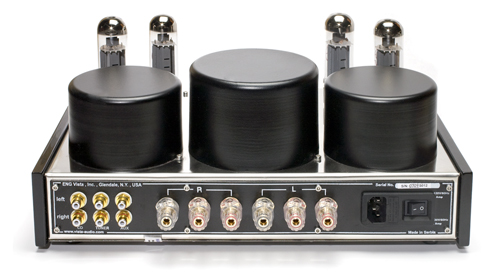
Final thoughts
There’s a solid selection of tube integrated amplifiers around the $1000 price range. At $980 the Vista Audio i34 holds it’s own very well. The fit and finish is excellent, with an understated vintage aesthetic. The overall presentation is excellent, with this amplifier providing a more refined sound than you would expect at this price point.
The Vista Audio i34 amplifier
MSRP: $980
Manufacturers Information
ENG Vista, Inc.
77-21 86th St
Ridgewood, NY 11385
A new headphone botique in Portland!
There’s a new way to buy headphones, headphone amplifiers and associated components. The first of it’s type in the US if not the world, is right here in Portland, in the stylish Hawthorne District. ALO Audio owner Ken Ball has opened a super cool store with walls of iPods, full of music, where you can audition every major headphone there is, in both stock form and hot rodded models that have been refitted with his own cables. If you’ve followed our “Headphone Planet” column, you know we at TONEAudio are very fond of ALO’s creations.
We’ll have a full feature soon in our “Dealers that make a difference” column in a future issue of TONEAudio Magazine.
But for now, if you need anything headphone related, we highly recommend visiting 32 Ohm Audio.
RMAF-Day Two
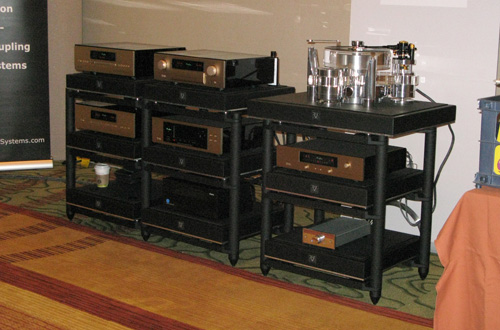 Another great day at the Rocky Mountain Audio Fest. Fest owner/presenter Marjorie Baumert announced that the Fest is go for next year and possibly as far as 2012. So, next year, show your support to convince Marjorie to stay on board!
Another great day at the Rocky Mountain Audio Fest. Fest owner/presenter Marjorie Baumert announced that the Fest is go for next year and possibly as far as 2012. So, next year, show your support to convince Marjorie to stay on board!
This show has grown a lot since its inception and has become a great destination point for industry members and audiophiles to mingle in a very relaxed atmosphere. Even the legendary Harry Pearson of The Absolute Sound made an appearance.
We’ve never posted any kind of “Best of Show” sound awards, because quite frankly, these are very challenging rooms, most nowhere near what you might listen to at home, so coming here to really judge the manufacturers wares is just not fair. Personally, I’m always amazed that they manage to do whatever it takes to actually GET the gear here in one piece and over to the show so that you can oogle it. The first room in the picture here was up on the mezzanine, where Axiss Audio was showing the Transrotor Turntable, with a full compliment of Accuphase electronics, Hansen speakers and Running Springs power conditioning.
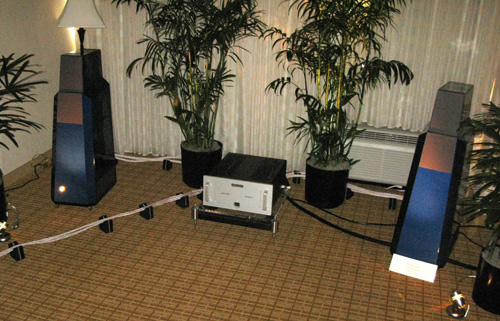 The folks at Shunyata, Vandersteen and Audio Research also did a very good job at defying the room acoustics, getting good sound out of a small room, bringing in some heavy duty room treatments and careful attention to setup. Just slightly off camera, they had a full bank of diffusors that did a great job at taming the room, along with a heavy dose of Shunyata’s latest Aurora cable, which we will have a full review in the next issue of TONEAudio.
The folks at Shunyata, Vandersteen and Audio Research also did a very good job at defying the room acoustics, getting good sound out of a small room, bringing in some heavy duty room treatments and careful attention to setup. Just slightly off camera, they had a full bank of diffusors that did a great job at taming the room, along with a heavy dose of Shunyata’s latest Aurora cable, which we will have a full review in the next issue of TONEAudio.
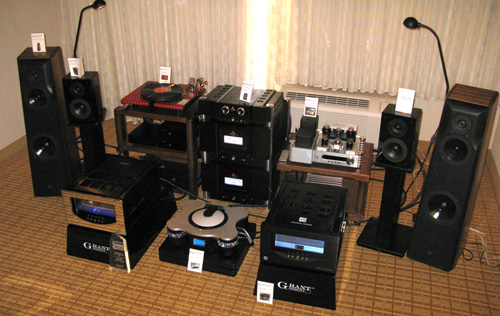
But it wasn’t all mega systems that were offering good sound. The folks at Grant Fidelity were showing off the Rita integrated amplifiers along with their newest small speakers that were under $2000 a pair. Look for a review soon.
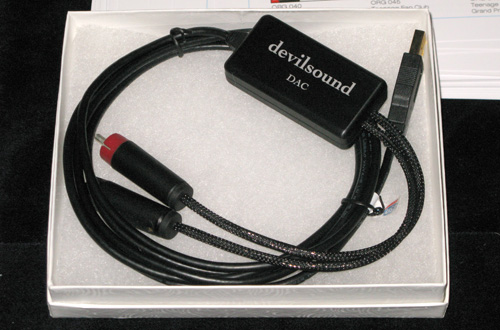 For me, the coolest products at the show were the “Devil Dac” shown in the Luxman room by Philip O’Hanlon, and a new battery powered DAC that will pull the digital bitstream from your iPod (just like the Wadia 170i) from the folks at ALO Audio and GR9 Technologies.
For me, the coolest products at the show were the “Devil Dac” shown in the Luxman room by Philip O’Hanlon, and a new battery powered DAC that will pull the digital bitstream from your iPod (just like the Wadia 170i) from the folks at ALO Audio and GR9 Technologies.
This is the future of audio folks, and not only does it sound great, it’s very easy to use, which I’m hoping will bring more people into our world.
And that’s what this show is really all about, the people and the interaction that takes place at the Rocky Mountain Audio fest is unmatched anywhere. So we end our coverage with a shot of the folks at Skiing Ninja. Sean is headed up to Portland in a couple of weeks to work his magic on my Magnepan 1.6’s, so watch for a full review soon. It should be fun. How could you not want to buy an upgrade from these guys?
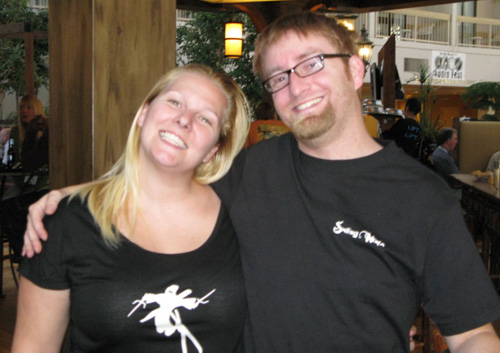
This show continues to get better every year, but the one thing I’d like to see after five years is some better music being played in the rooms. I heard a few people getting slightly out of the box playing a little bit of electronic music and I thought I heard Van Halen coming out of one room, but it was way TOO MUCH female vocals again.
Nothing but the standard, Eva Cassidy, Allison Krauss and Patricia Barber. And if I ever hear “Keith Don’t Go” by Nils Lofgren again, I’m gonna hurt somebody. This is why we can’t get anyone under 50 interested in hifi. So your homework assignment for next year is to bring some interesting music!
RMAF: Day One
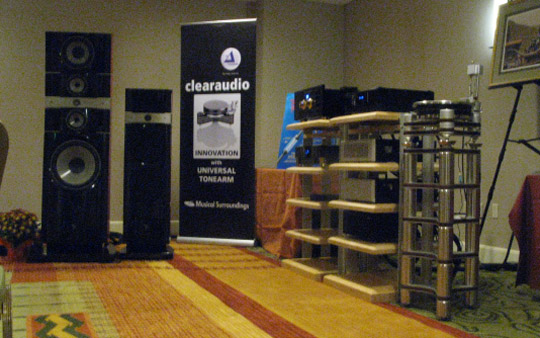 The Rocky Mountain Audio Fest got off to a great start in Denver today, with a very chilled out start time of noon, which was a benefit for exhibitors arriving from the East Coast and Europe.
The Rocky Mountain Audio Fest got off to a great start in Denver today, with a very chilled out start time of noon, which was a benefit for exhibitors arriving from the East Coast and Europe.
The first stop on my agenda was the Audio Unlimited suite, with the Focal Grande Utopia EM’s powered by MBL Gear and Running Springs new power line conditioner. Vinyl was spinning on the new Clearaudio Innovation table (watch for a full review in the next issue of TONEAudio) allowing the Grande Utopia’s to put on a great show. So far, this looks to be one of the most exciting rooms at the show.
Next stop, the Naim press conference, where their new speaker the Ovator was revealed. More about this tomorrow, when I interview the speaker’s designer.
You know I’m a panel lover, so I was very intrigued by the demo of the King’s Audio Electrostatics. At $8,000 a pair the speaker was very impressive, with excellent bass for a full range electrostatic speaker.
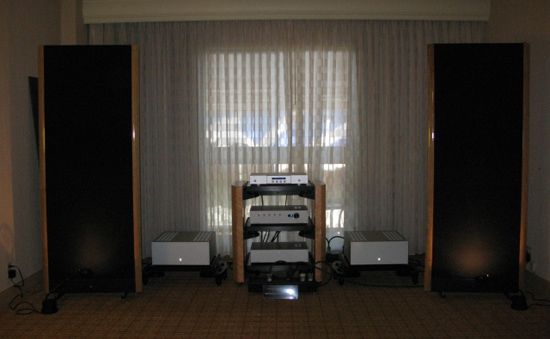
The rest of the day was spent catching up and exploring the layout of this year’s show. More in depth tomorrow when we have a full day. Stay tuned!
Please note that all TONE and TONE related text and images are copyright © 2005–2025 TONE Magazine and The Audiophile Apartment. The RSS feed provided is for personal, non-commercial use only.
If you are not reading this content in your news aggregator, RSS reader, or direct, then the site you are looking at may be guilty of copyright infringement. If you locate this anywhere, please contact jeff@tonepublications.com so we can take action immediately.




